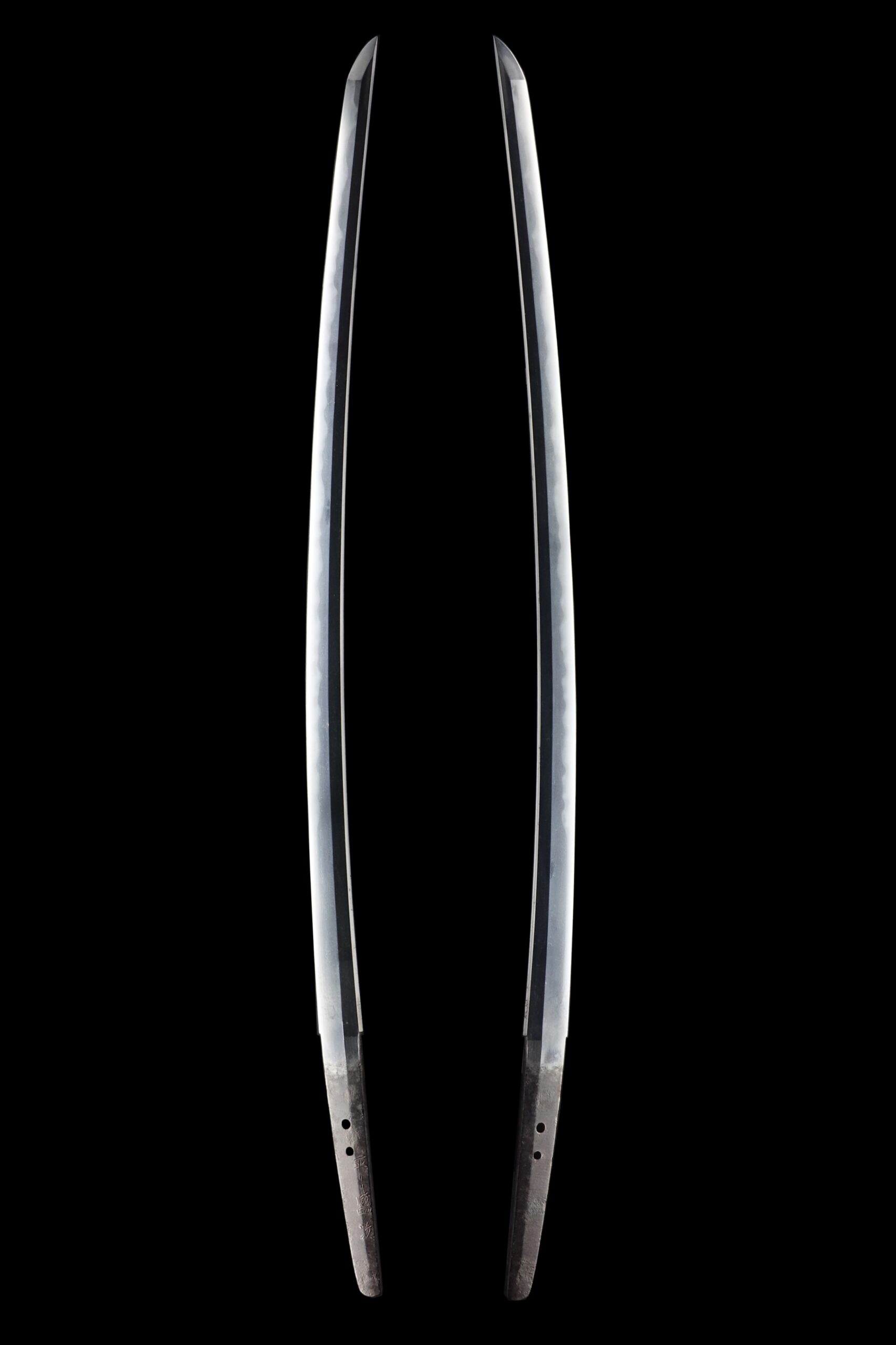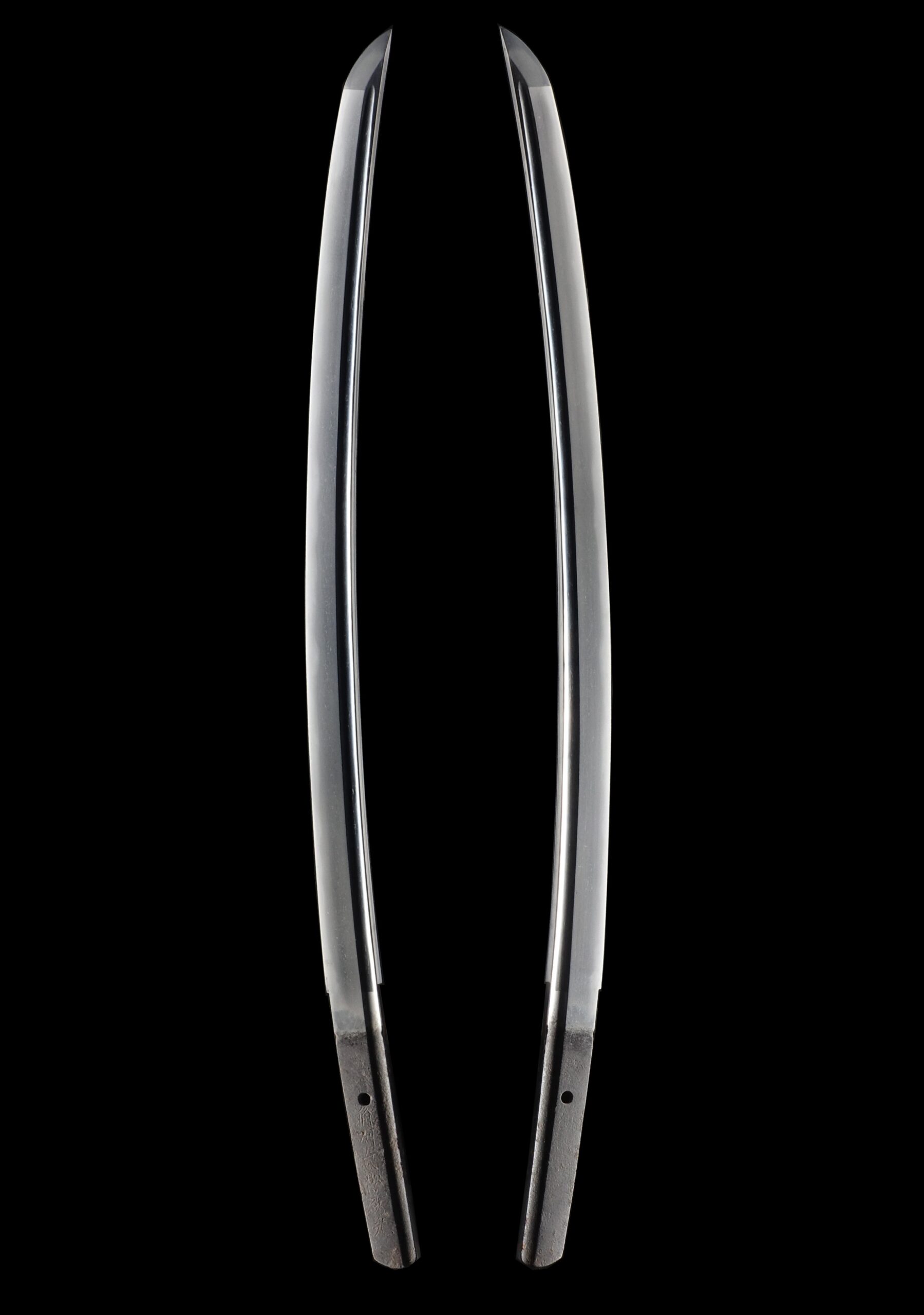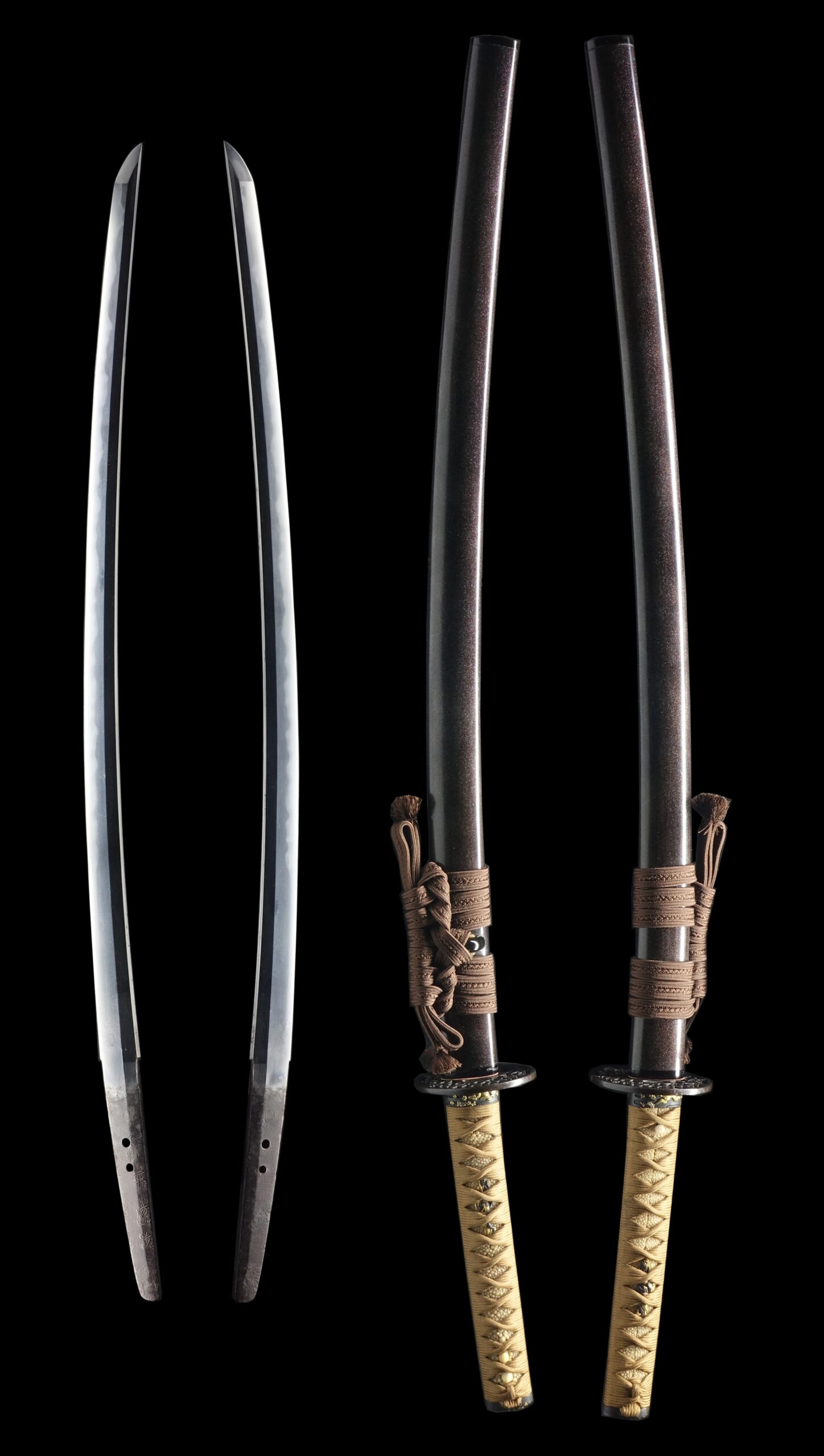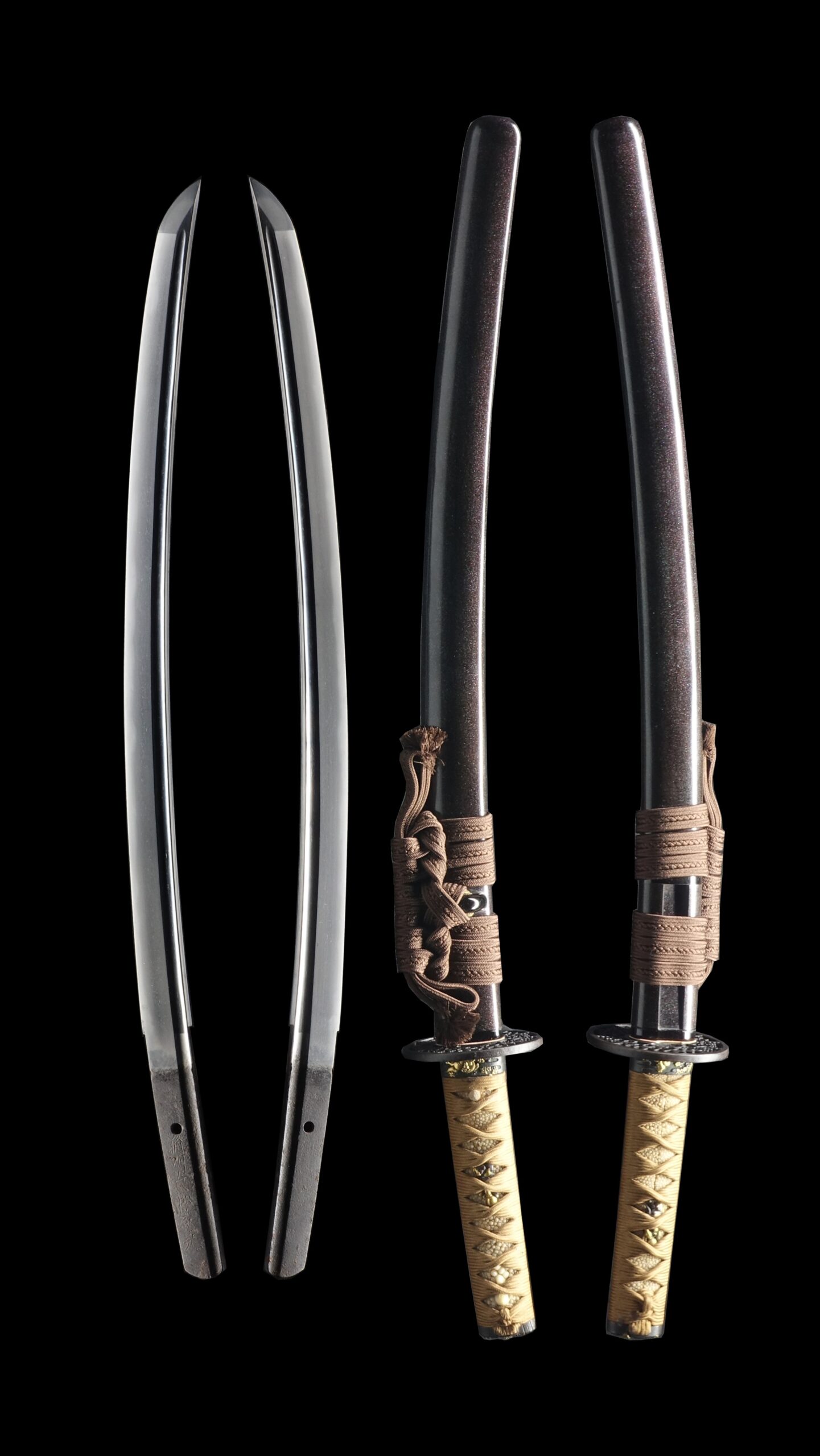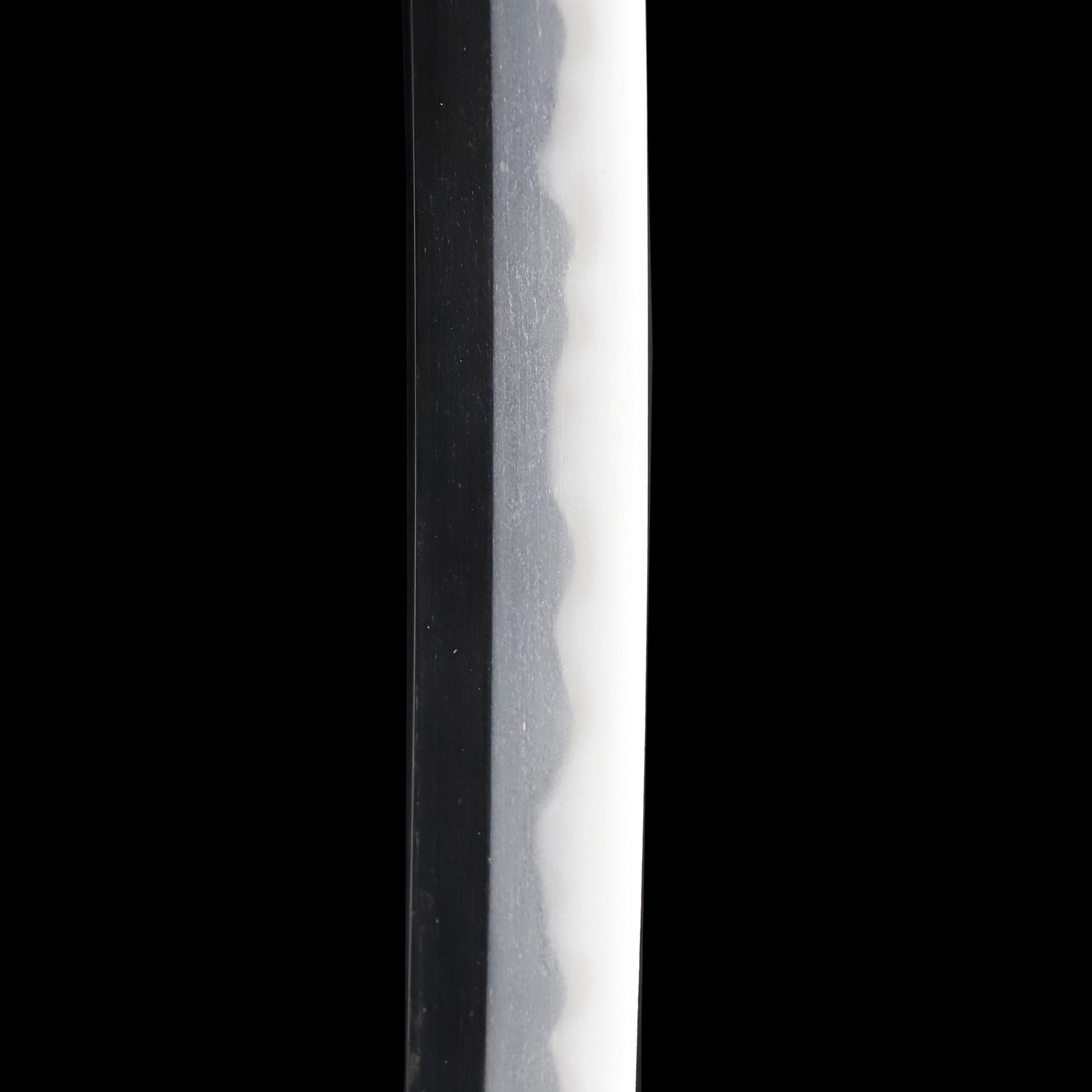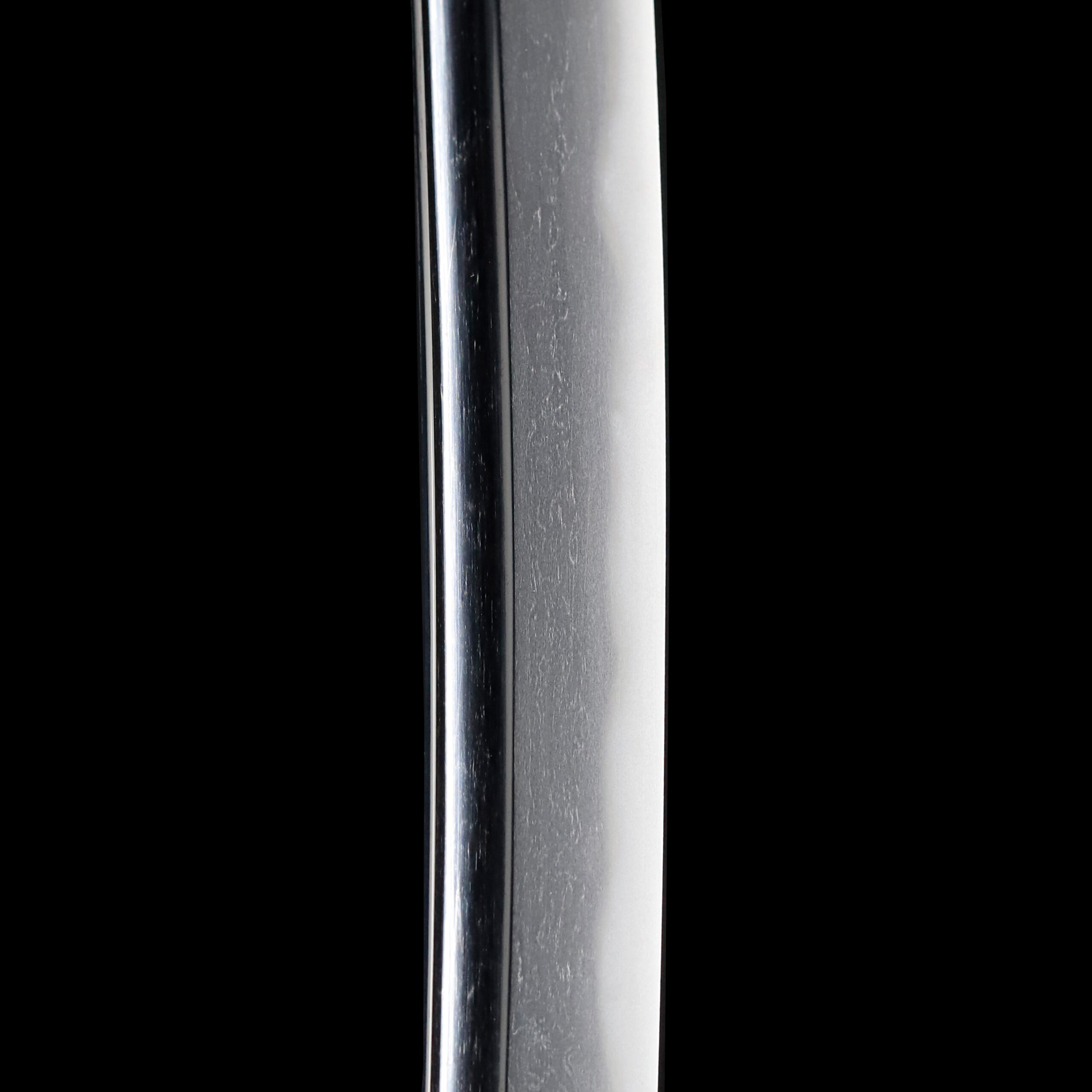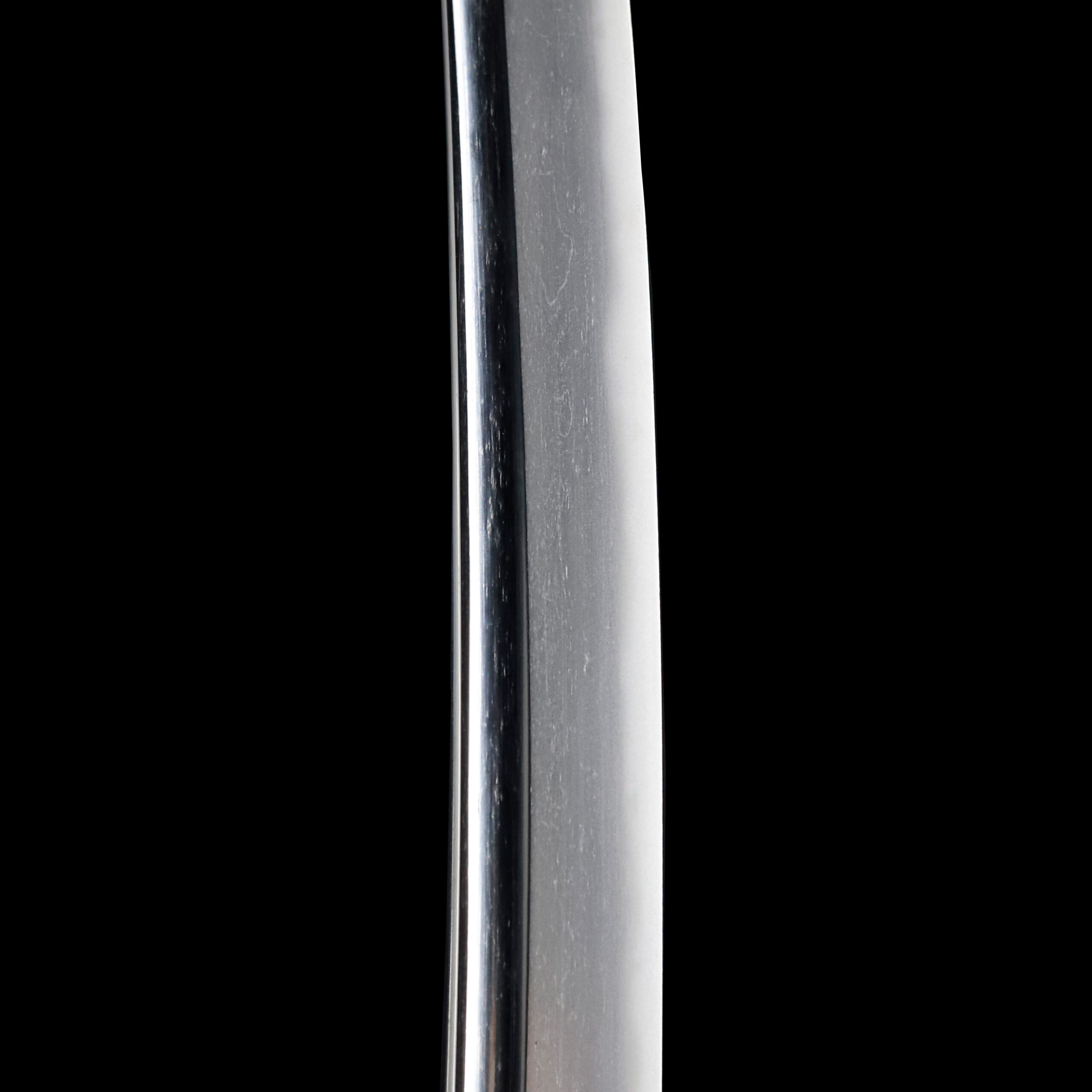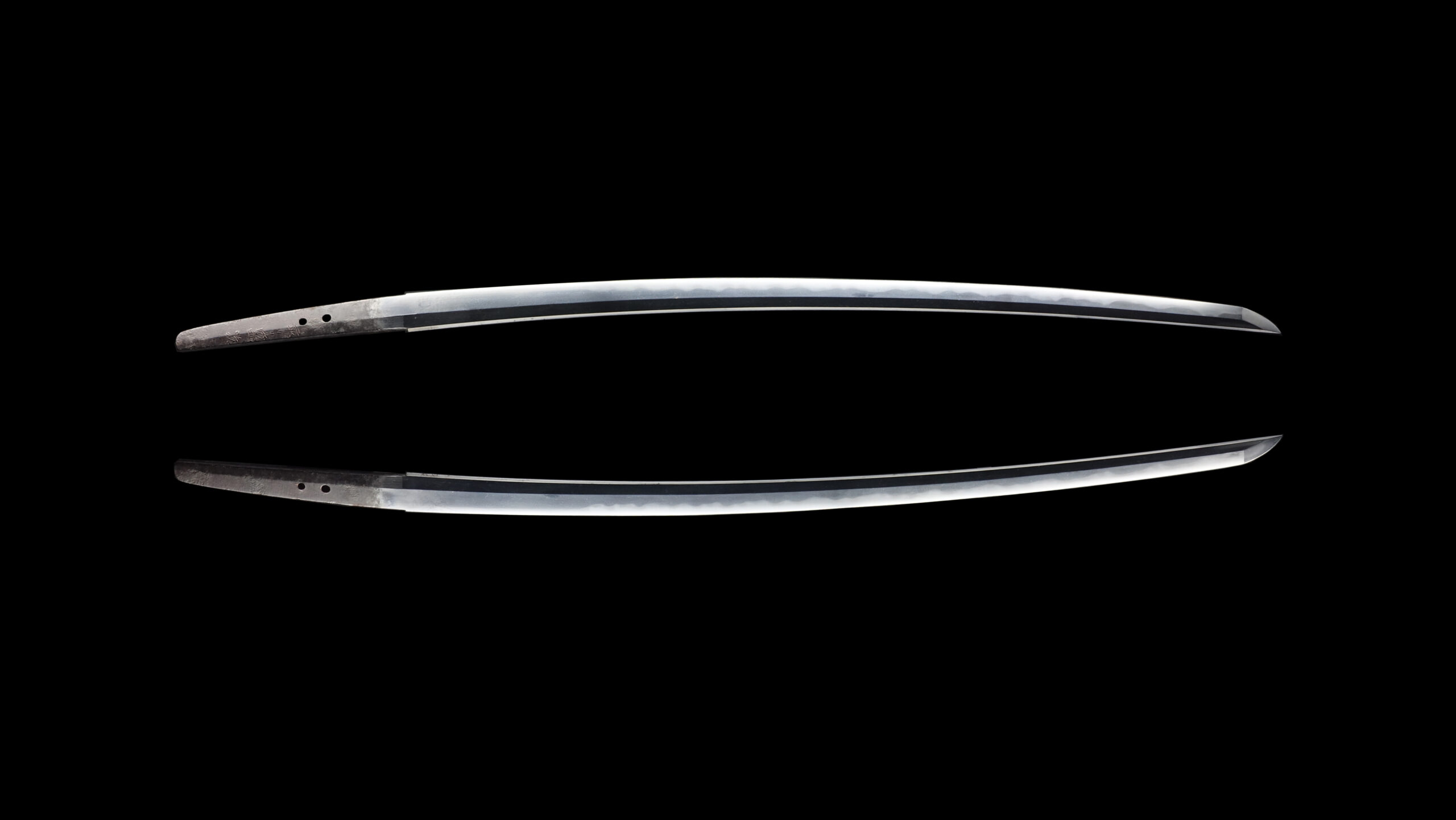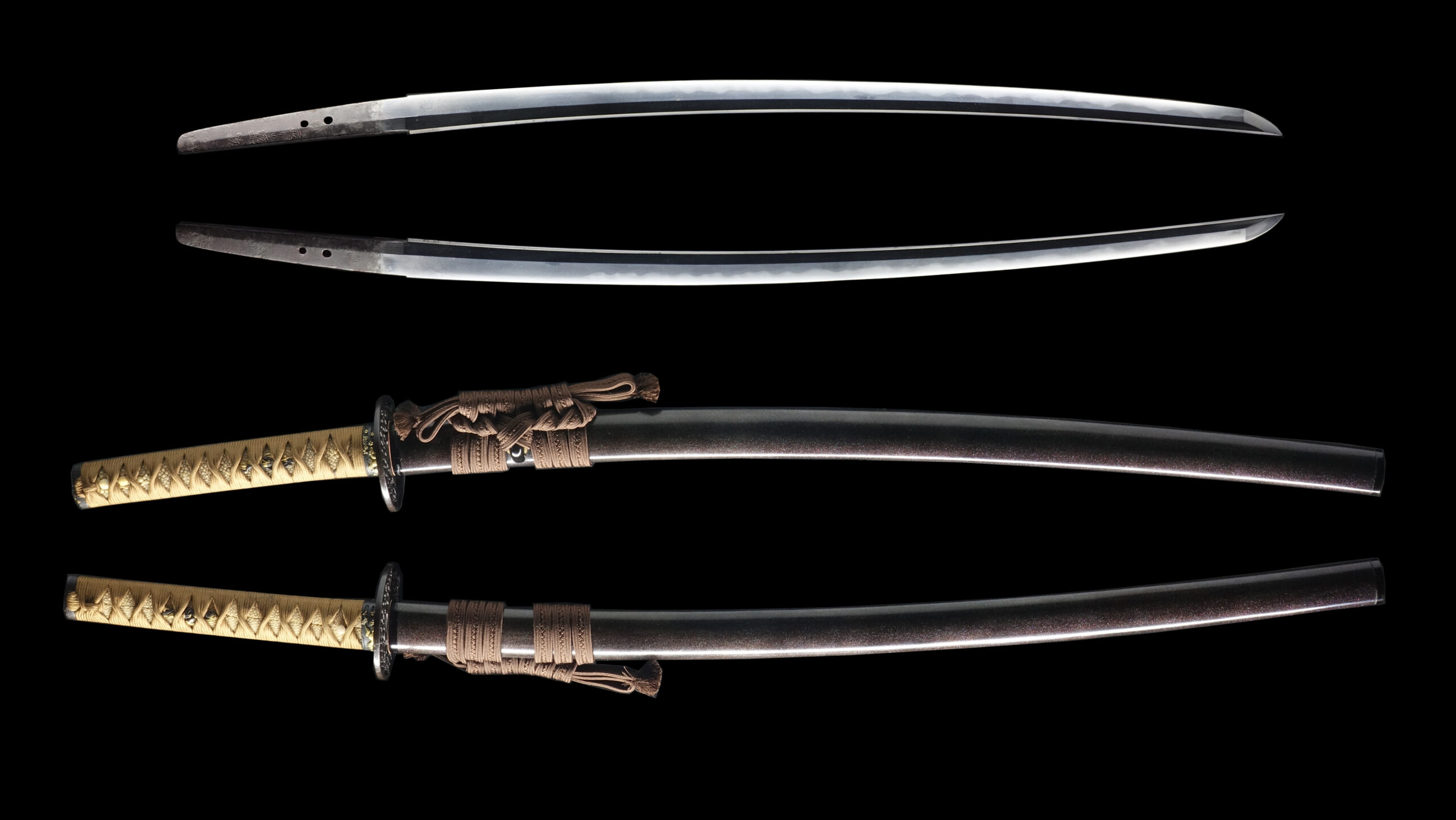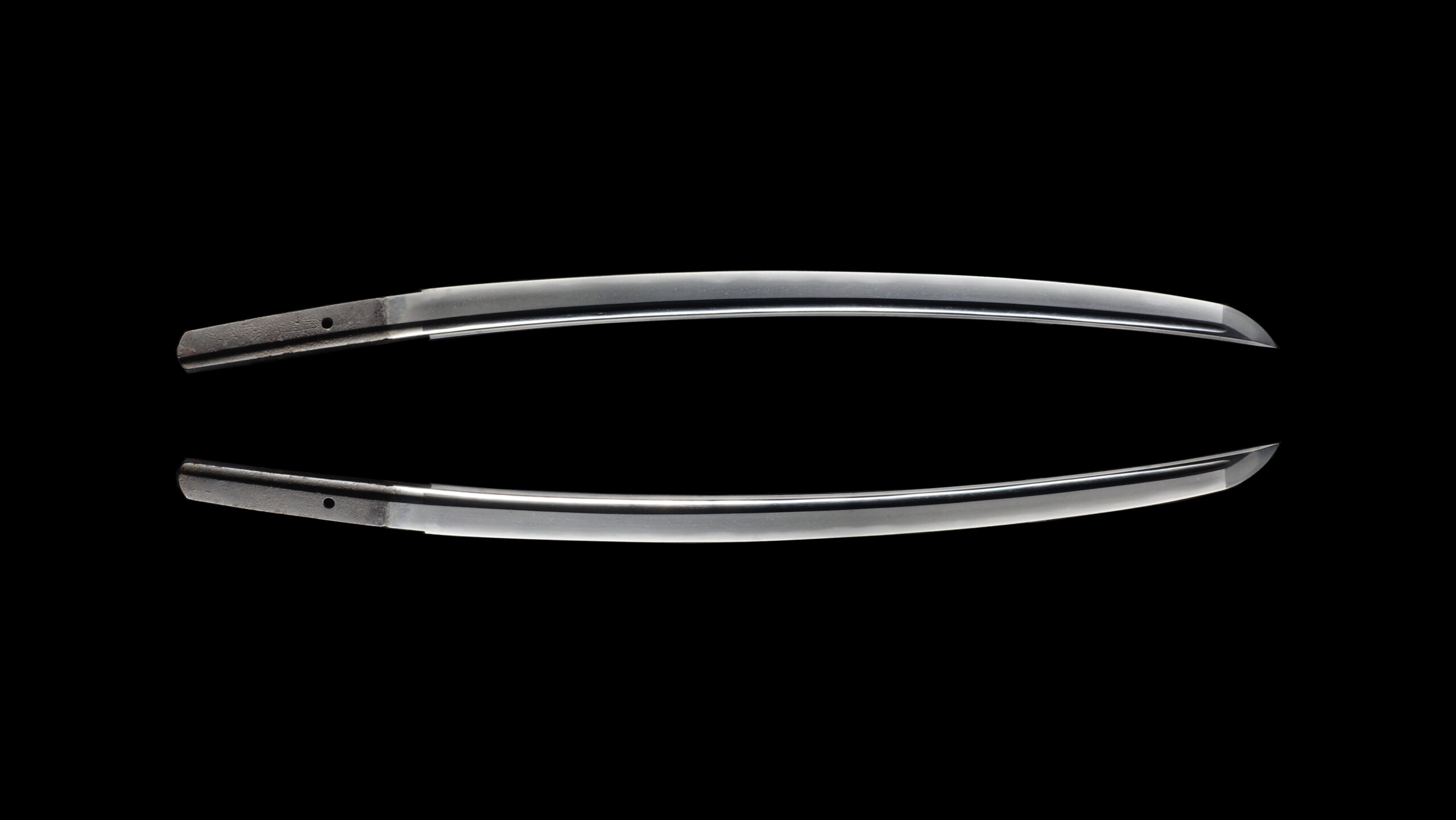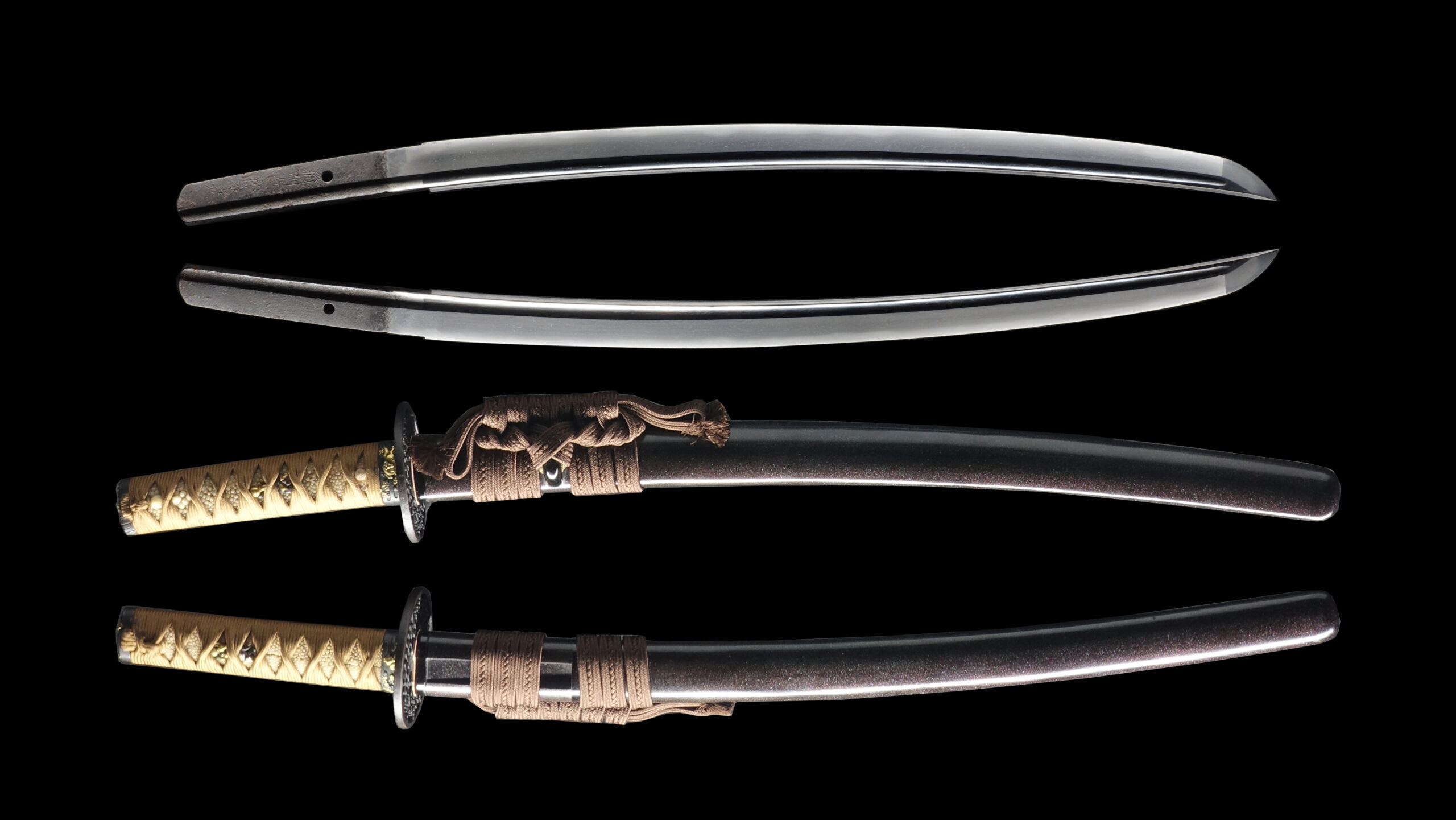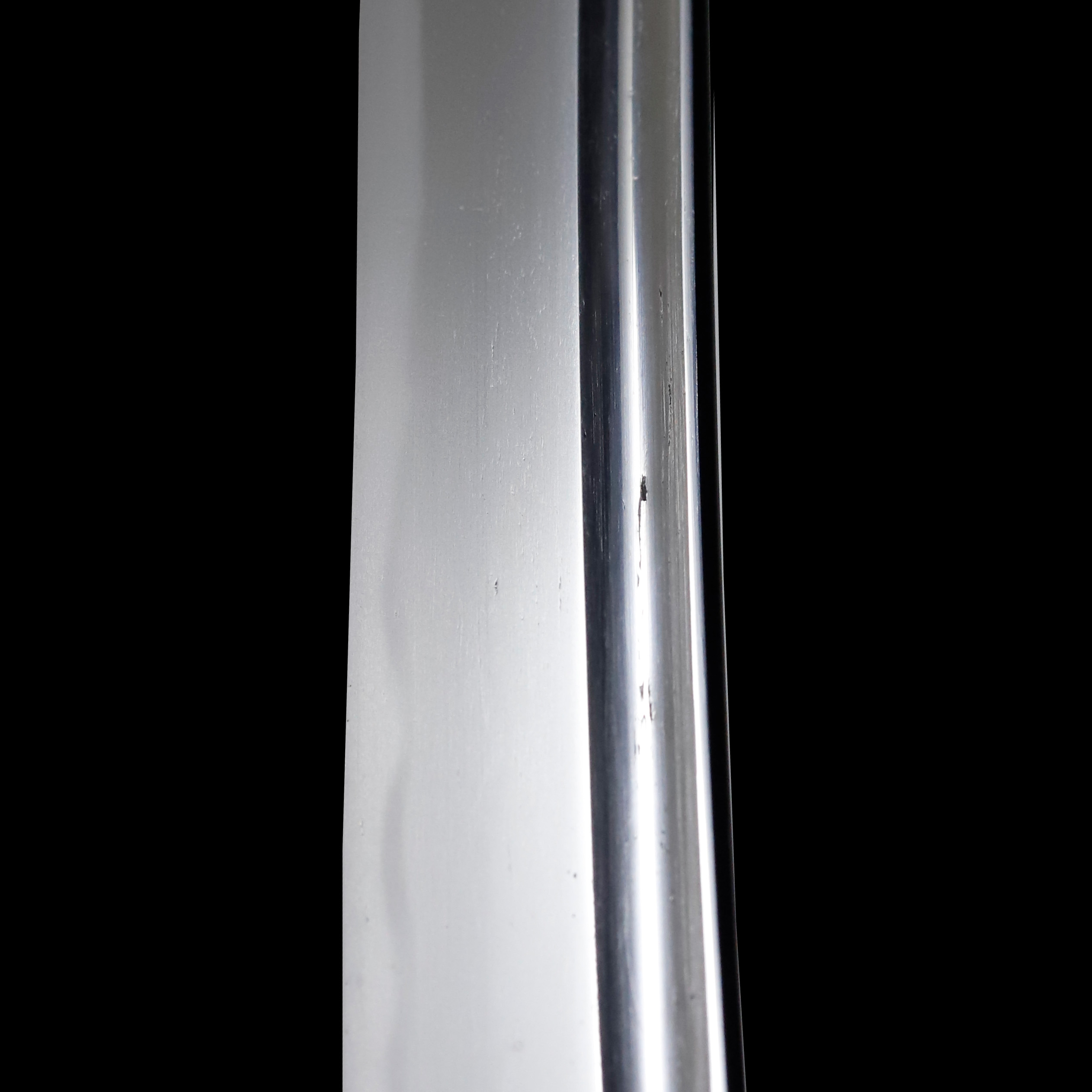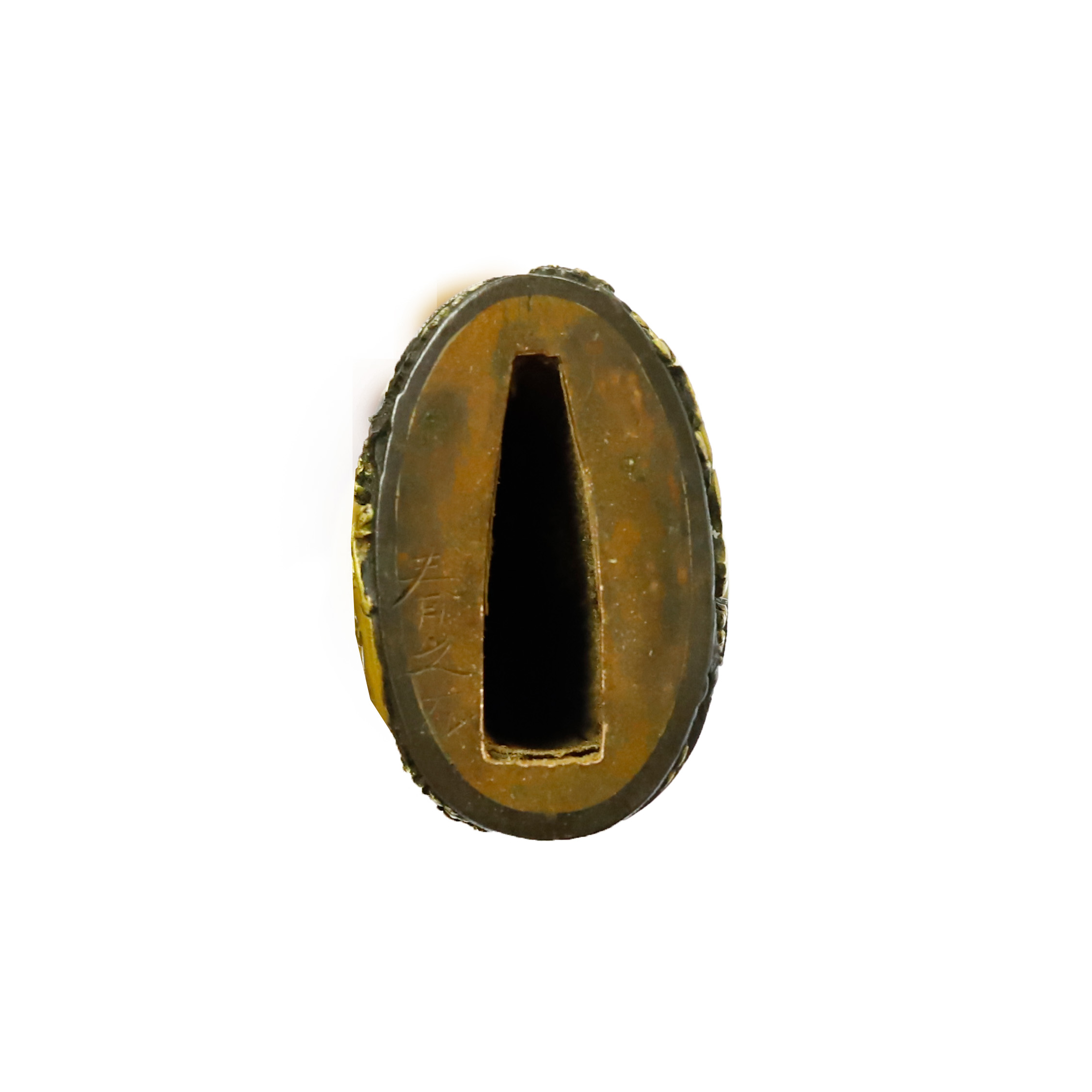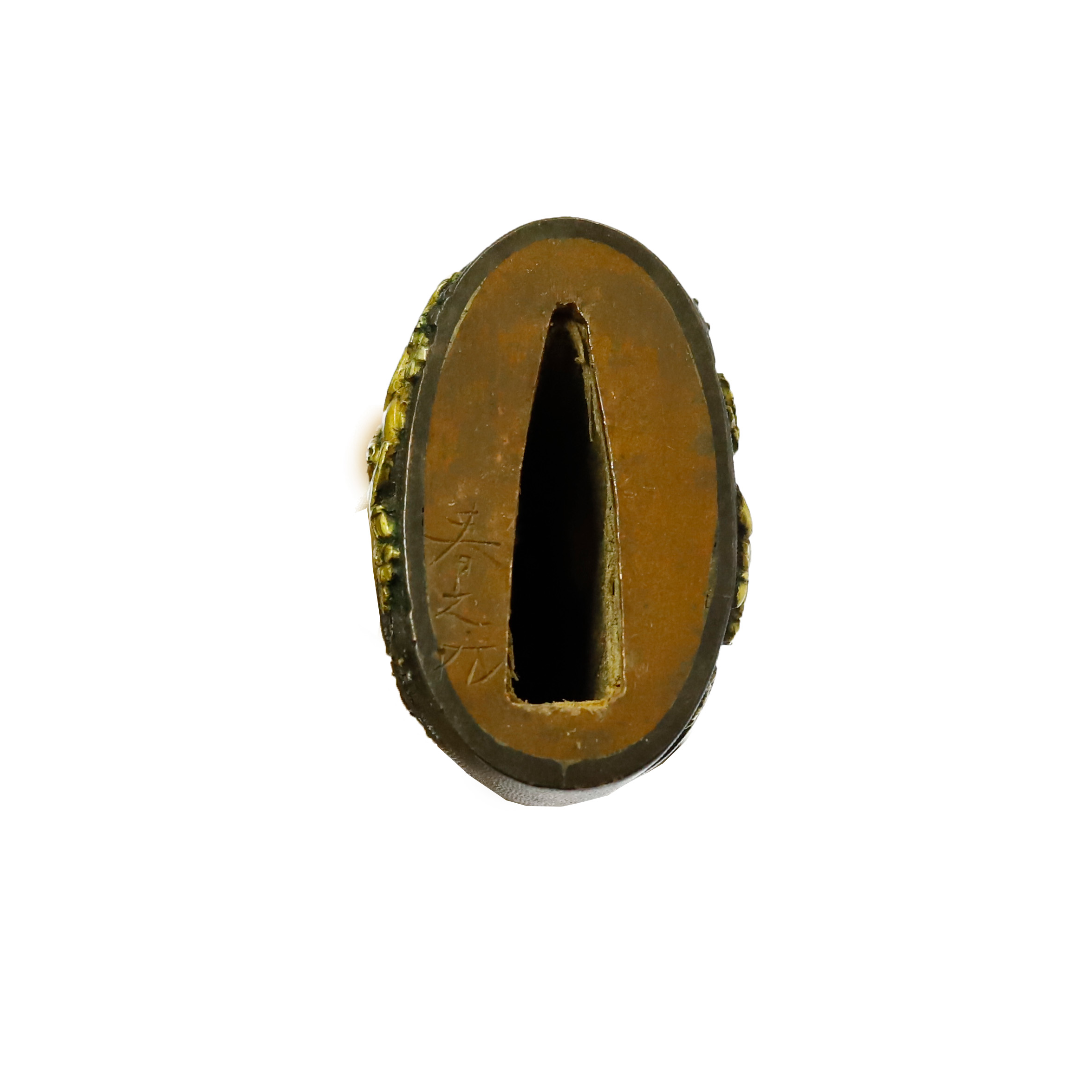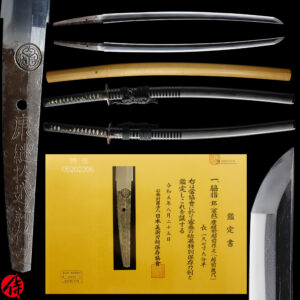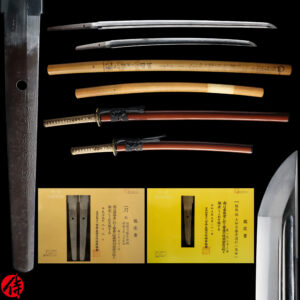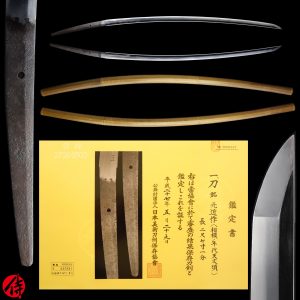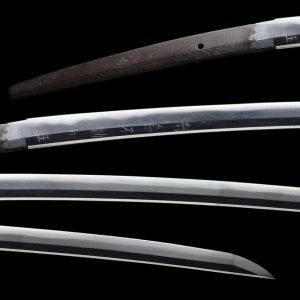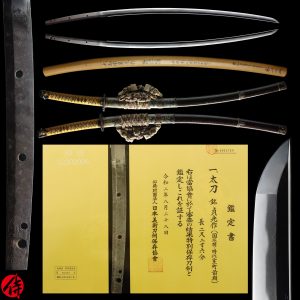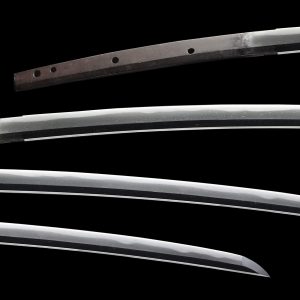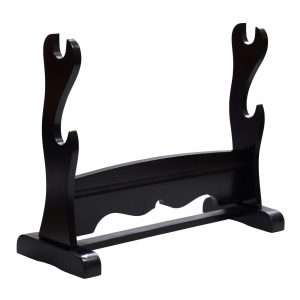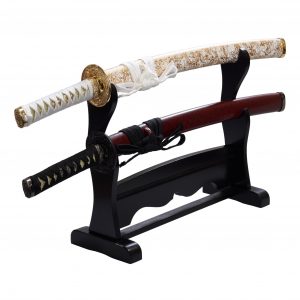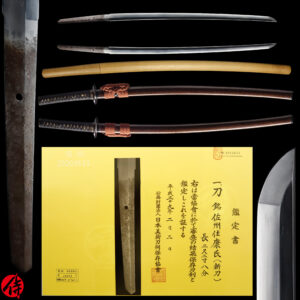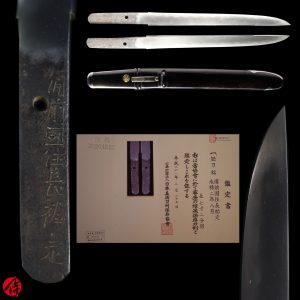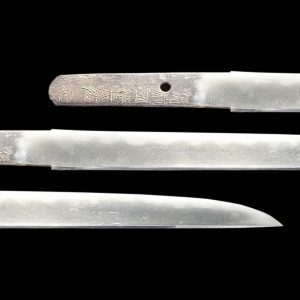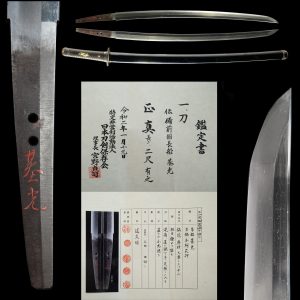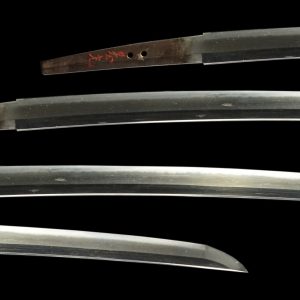Antique Japanese Sword Daisho Signed by Taira Moritsugu /Osafune Hidemitsu with NBTHK Tokubetsu Hozon Certificate
【Description】
-Katana
This blade was signed by Taira Moritsugu (平盛次), who belonged to a prestigious school named Takada(高田). He was active during the Tenbun era (1532-1554: Late Muromachi period).
Takada school was founded by Takada Tomoyuki in Takada village, Bungo domain(Ohita prefecture), during the Nanbokucho period. (1334-1338 A.D). Takada Tomoyuki went to Bizen province(today’s Okayama prefecture) to master the sword-forging techniques of BIZEN and returned to the village and trained his apprentices. That is how Takada school started.
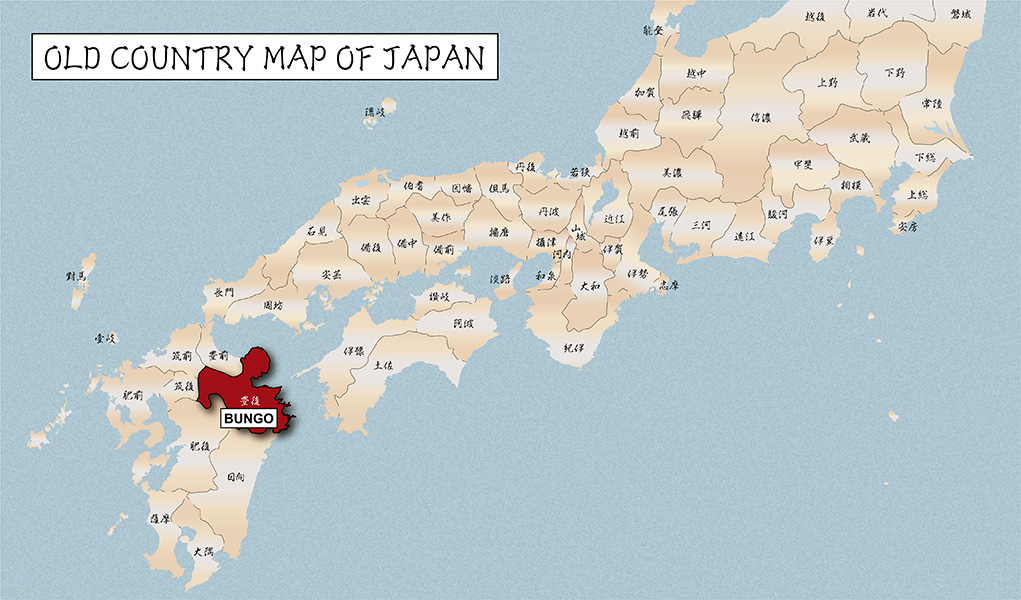
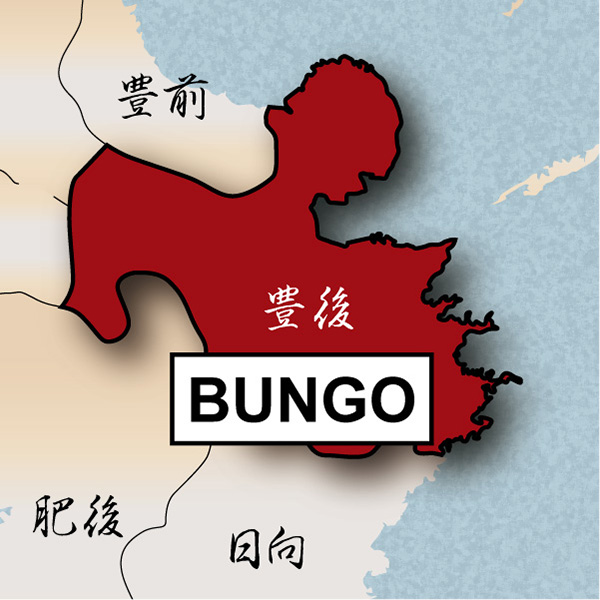
Those who forged swords in Takada village before the Edo period were called Taira Takada and Fujiwara Takada during the Edo period. This blade is categorized as a Taira Takada.
During Sengoku Period(the warring state period: from late 15 C to late 16 C), the Takada school forged many swords for many Samurais in Kyushu island. It is said that the reputation of the blades forged by Takada school was close to MINO or BIZEN swords, two of which are the most famous sword forging places.
The Bungo domain was ruled by Otomo Yoshishige(Sorin) during the Sengoku period. Yoshishige and his domain built a strong military and political base there. Yoshishige was known as one of the most famous warlords on Kyushu island. It is said that Takada swordsmiths forged swords for those who served the Otomo clan.
Generally speaking, Kyushu island was prosperous in sword-making because of its long trading history with Asian countries. Many feudal lords on this island fought against each other to gain an advantage in trading. Takada school received many orders as the demand increased among those lords.
The material of Japanese swords(high-quality iron sand and charcoal) was abundant in mount Sobo Katamuki, located near Takada village. We believe Takada school prospered because of its geographic location and natural resources.
-Wakizashi
This blade was signed by Osafune Hidemitsu (長船秀光) during the mid Muromachi period (Approx. 500 years old). The maker’s name Hidemitsu lasted a few generations.
The first-gen was active during the Kenmu era (1334-1336: Early Nanbokucho era). The second-fourth of generations were active during 1368-1394 (mid-Nanbokucho-early Muromachi period). Based on this records and the information NBTHK provided in the authentication paper, we believe this was created by a later generation Hidemitsu than the fourth generation.
The generations of Hidemitsu resided in Bizen province (Today’s Okayama prefecture). The first-gen Hidemitsu was categorized as a Kozori swordsmith. Kozori is a group of swordsmiths who belonged to Osafune school in Bizen during the Nanbokucho Period but wasn’t part of major branches such as Kanemitsu school. Other famous swordsmiths seen as Kozori are Morimitsu, Yasumitsu, and Norimitsu.
It is said that Osafune school was founded by Mitsutada (光忠), who was active during the mid-Kamakura period. Bizen Osafune school was the biggest one of all other schools in Bizen province, and they received many orders from feudal lords or renowned Samurai. They were called Osafunemono and beloved by Samurai warriors.
Among the swordsmiths who belonged to this school, Nagamitsu, Sanenaga, and Kagemitsu are known as Osafune Sansaku, the three renowned Osafune swordsmiths. There are also four other prominent swordsmiths who were from Bizen Osafune school. They are called Osafune Shiten-no, the four masters of Osafune school. Their names are Nagamitsu, Kanemitsu, Nagayoshi, and Motoshige.
BIZEN is located near the Chugoku Mountains, where iron sands, one of the essential materials for making Japanese swords, were abundant. Furthermore, BIZEN swordsmiths had close access to Yoshi River, where they could find water and charcoal. This geological location contributed to the swordsmiths forging high-quality refined blades. We presume BIZEN was quite active in sword-forging from ancient times. It is said that BIZEN DEN was created by groups of swordsmiths there during the late Heian era (Late 12th century ). These ancient swordsmiths in Bizen province are called Ko-Bizen (Old Bizen) swordsmiths. By inheriting the sword forging techniques from Ko-Bizen swordsmiths, the Bizen Osafune school flourished from the mid-Kamakura period.
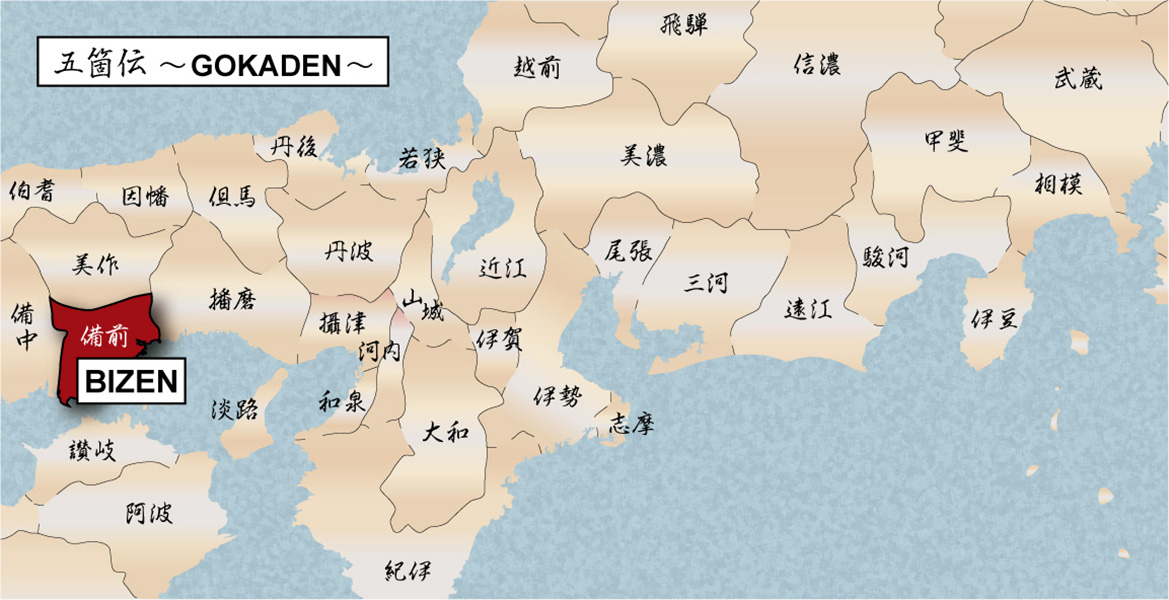
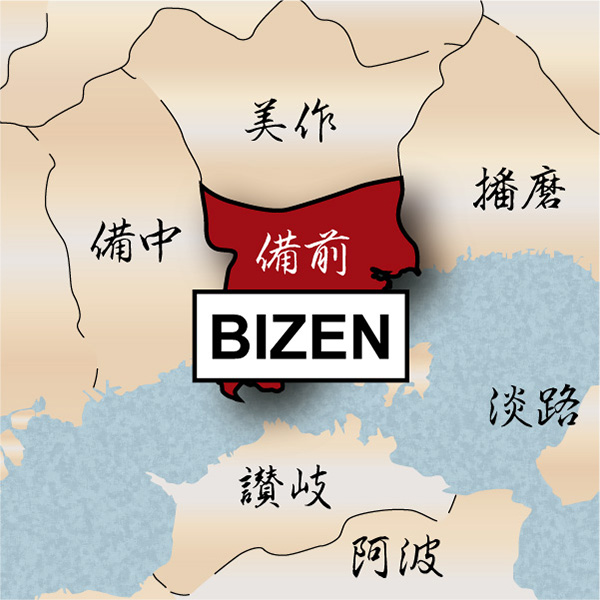
What is Daisho?
Daisho is a pair of two Japanese swords Samurai carried. During the Edo period, having Daisho in public places was considered social status for Samurai. Furthermore, Samurai were required to wear them under the law back then. Daisho is written as 大=Big and 小=Small. Dai part means Katana, and Sho part means Wakizashi. We are confident you would like this pair of Daisho Koshirae.
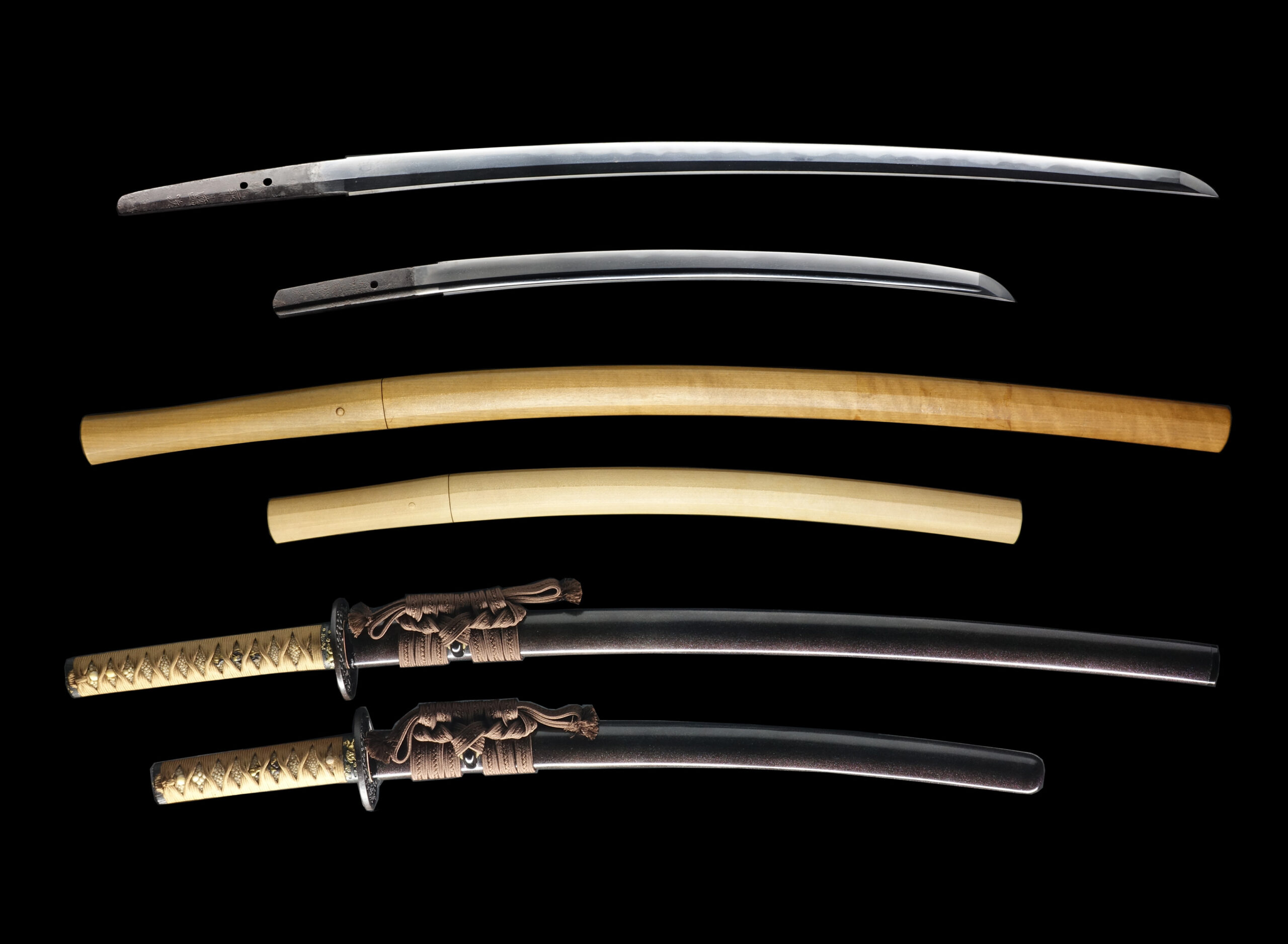
Appraisal
This Katana/Wakizashi blade are appraised as a Tokubetsu Hozon Token(特別保存刀剣) . They were issued by NBTHK(Nihon Bijutsu Touken Hozon Kyokai:日本美術刀剣保存協会). These authentication papers were only given to authentic Japanese swords, especially well preserved and high quality with artistic value.
【 Blade】
-Katana
Cutting Edge Length(Nagasa):62.5 cm ( 24.6 inches)
Curvature(Sori):1.8 cm (0.70 inches)

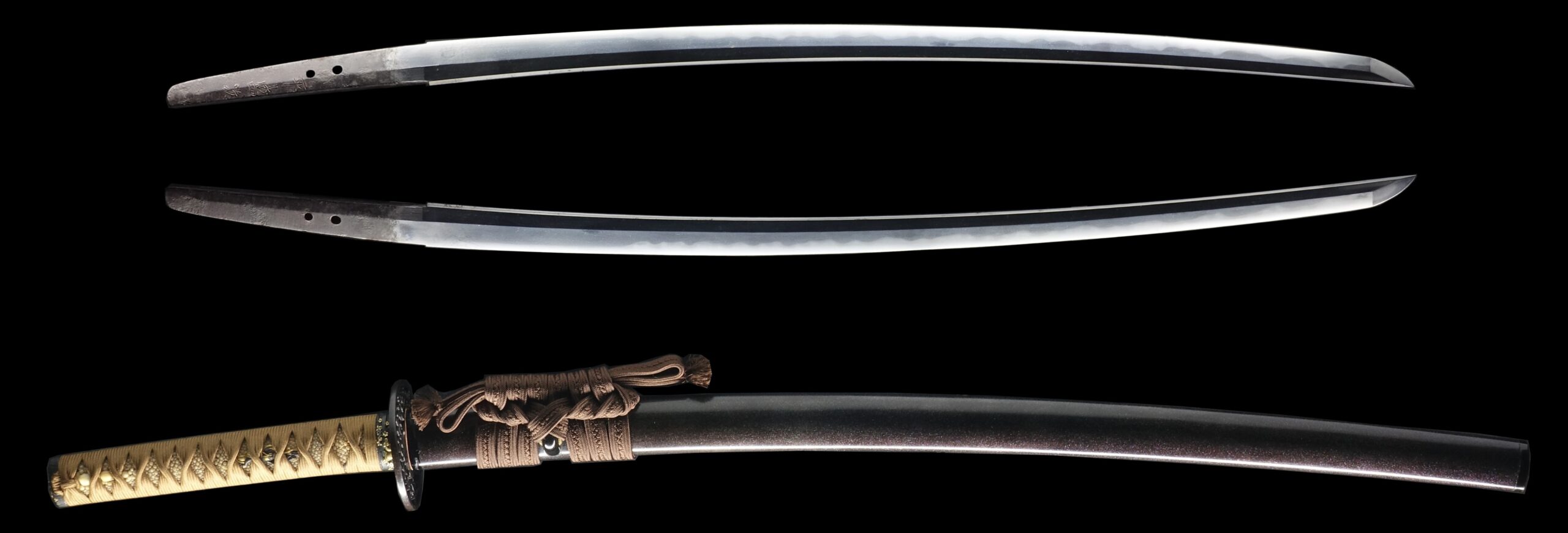
-Wakizashi
Cutting Edge Length(Nagasa): 41.0 cm ( 16.1 inches)
Curvature(Sori):1.5 cm ( 0.59 inches)

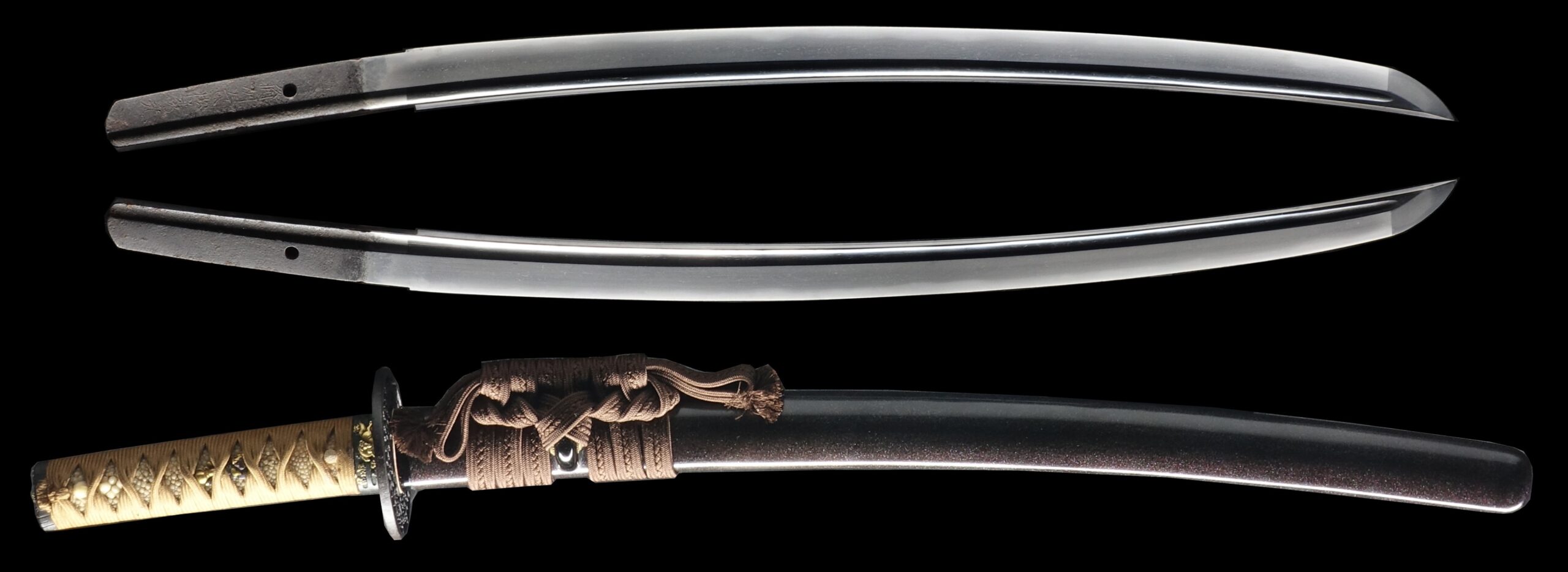
Hamon:
The crystalline structure which forms along the cutting edge of a blade as a result of the hardening process
Jimon(Jihada):
visible steel surface pattern created by folding and hammering during forging process
-Katana
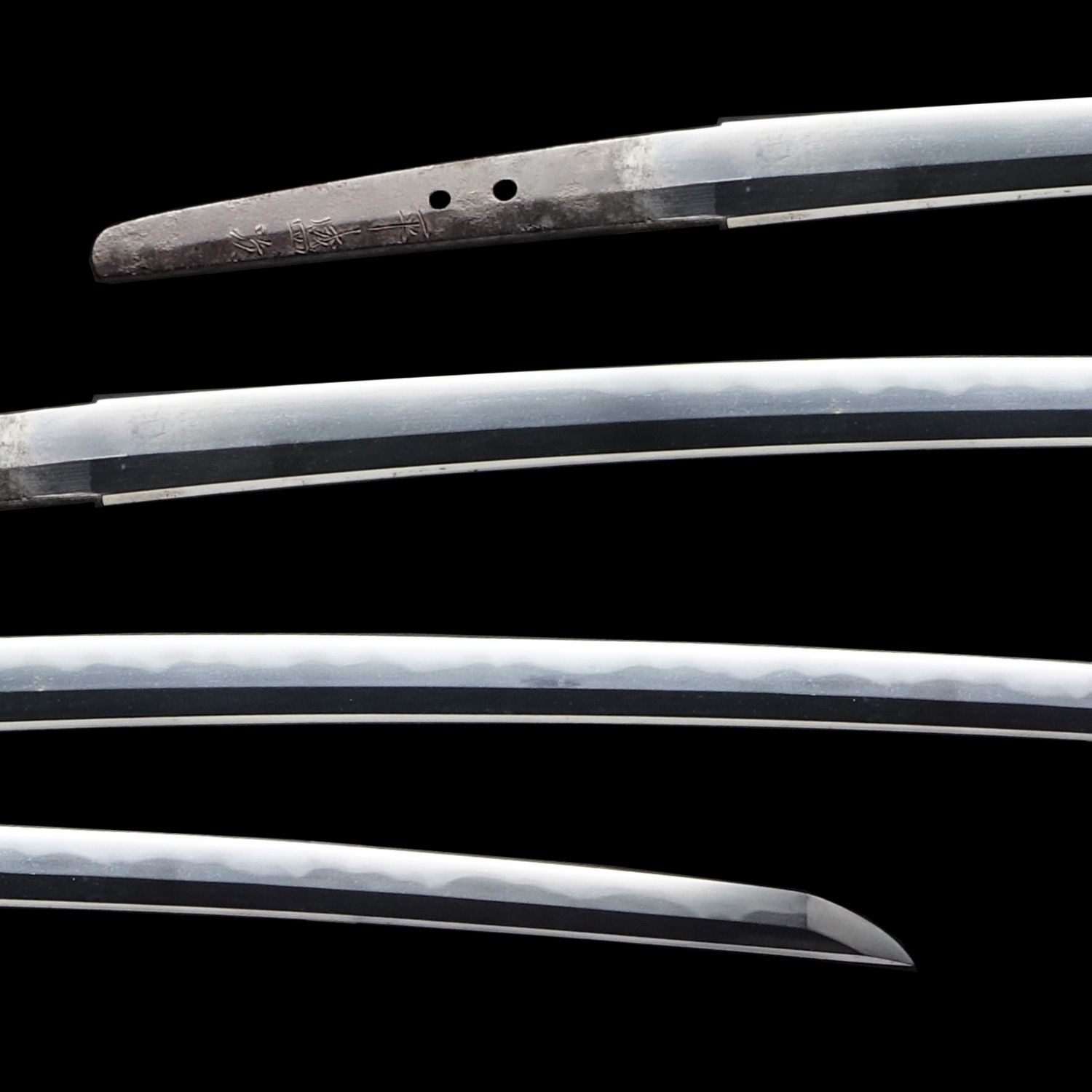
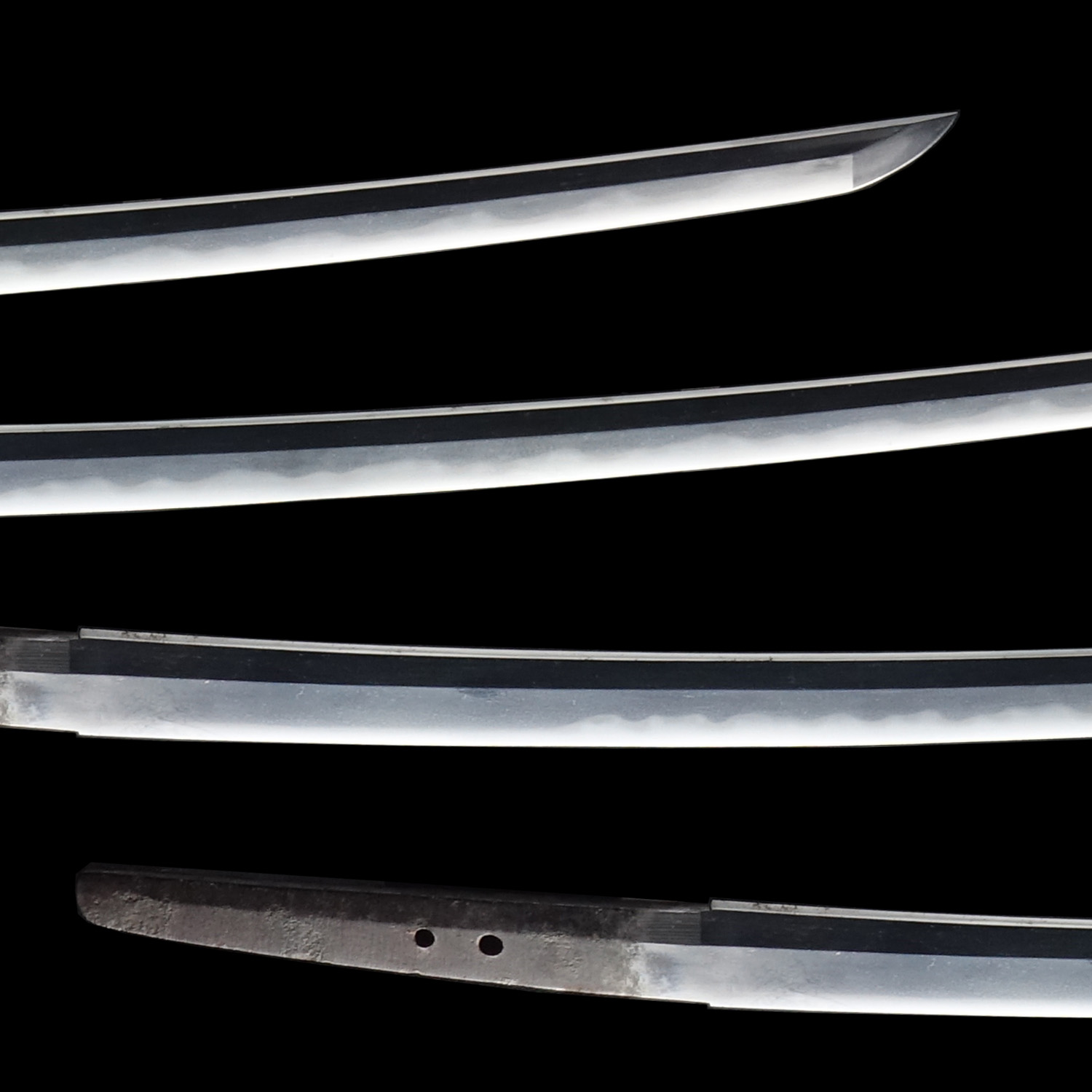
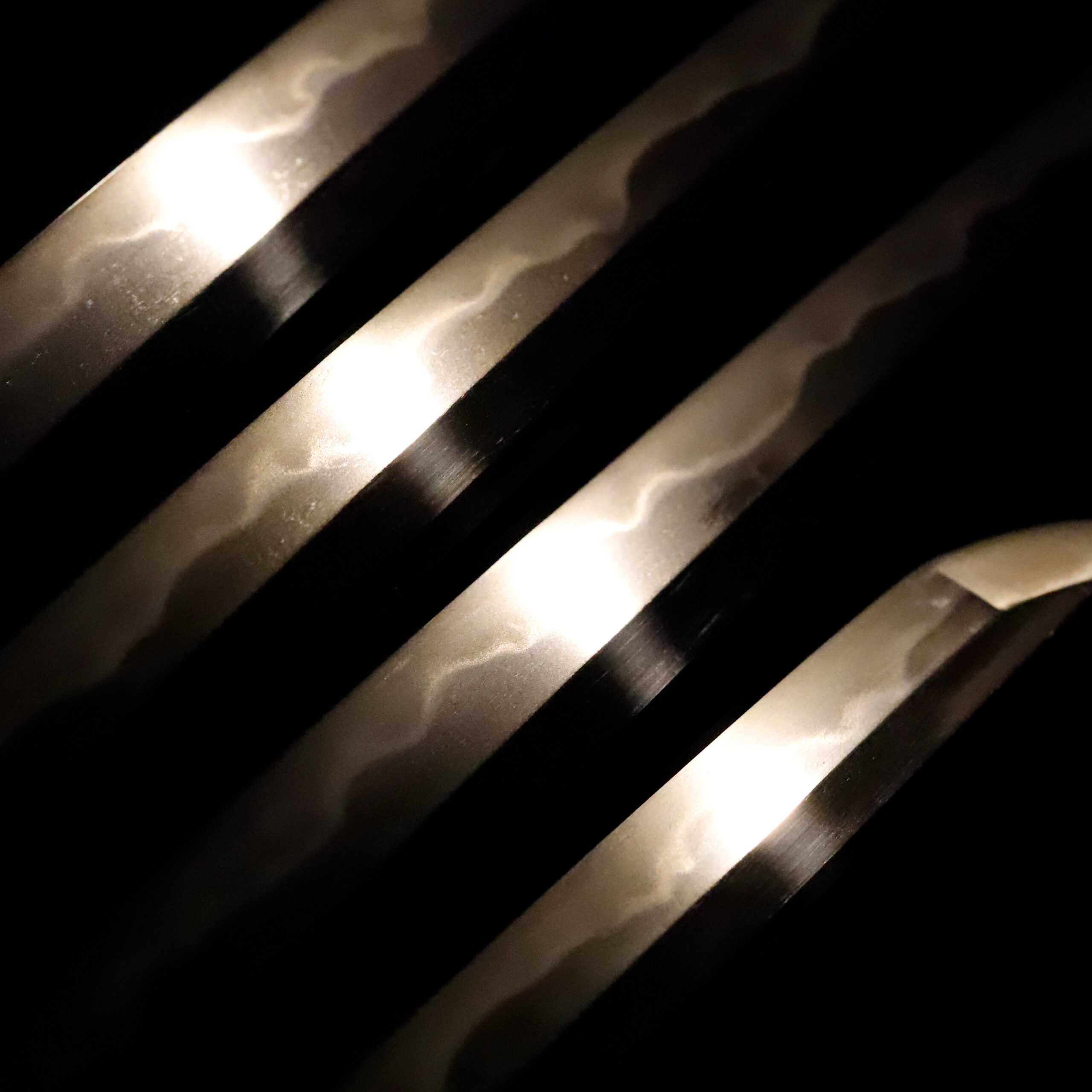
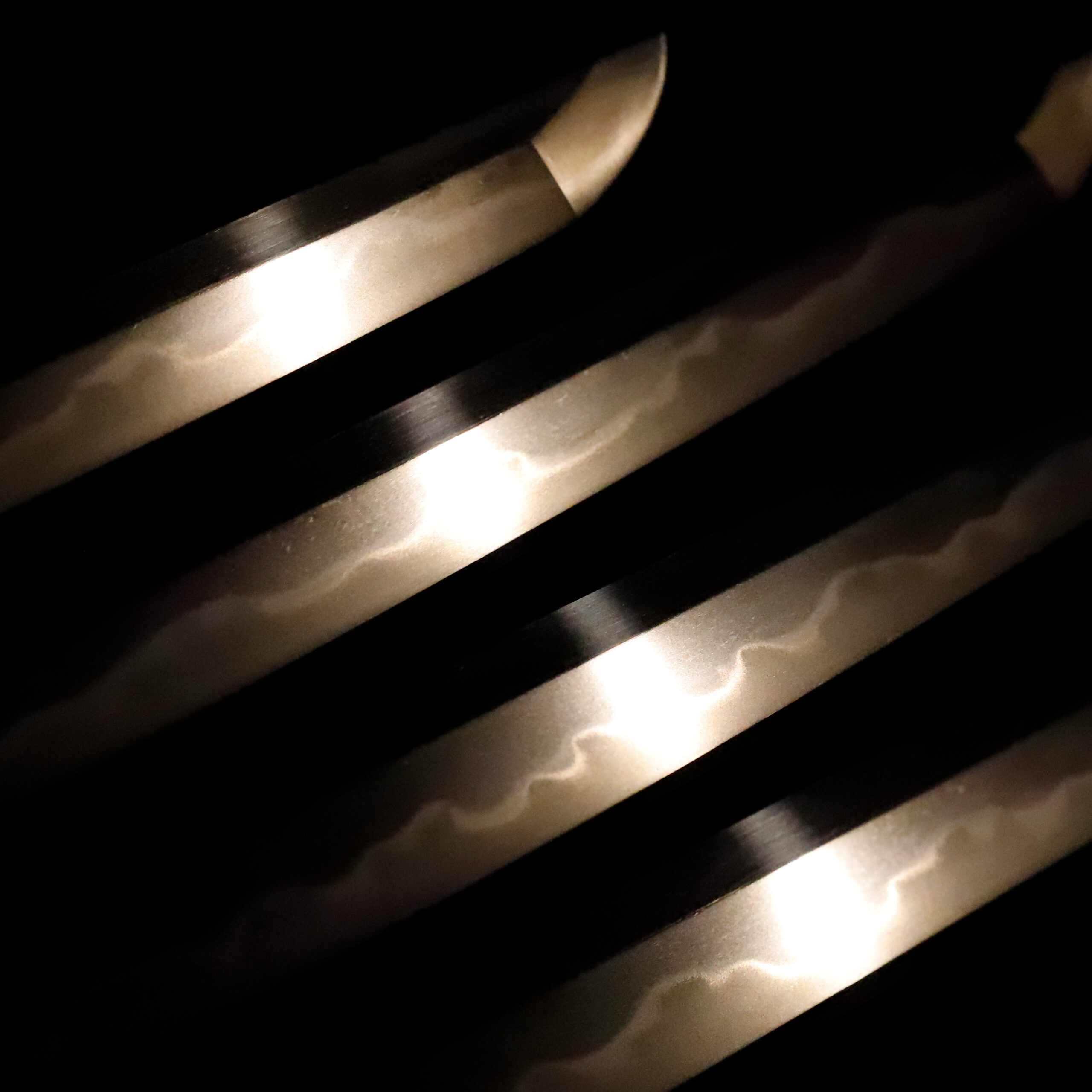
-Wakizashi
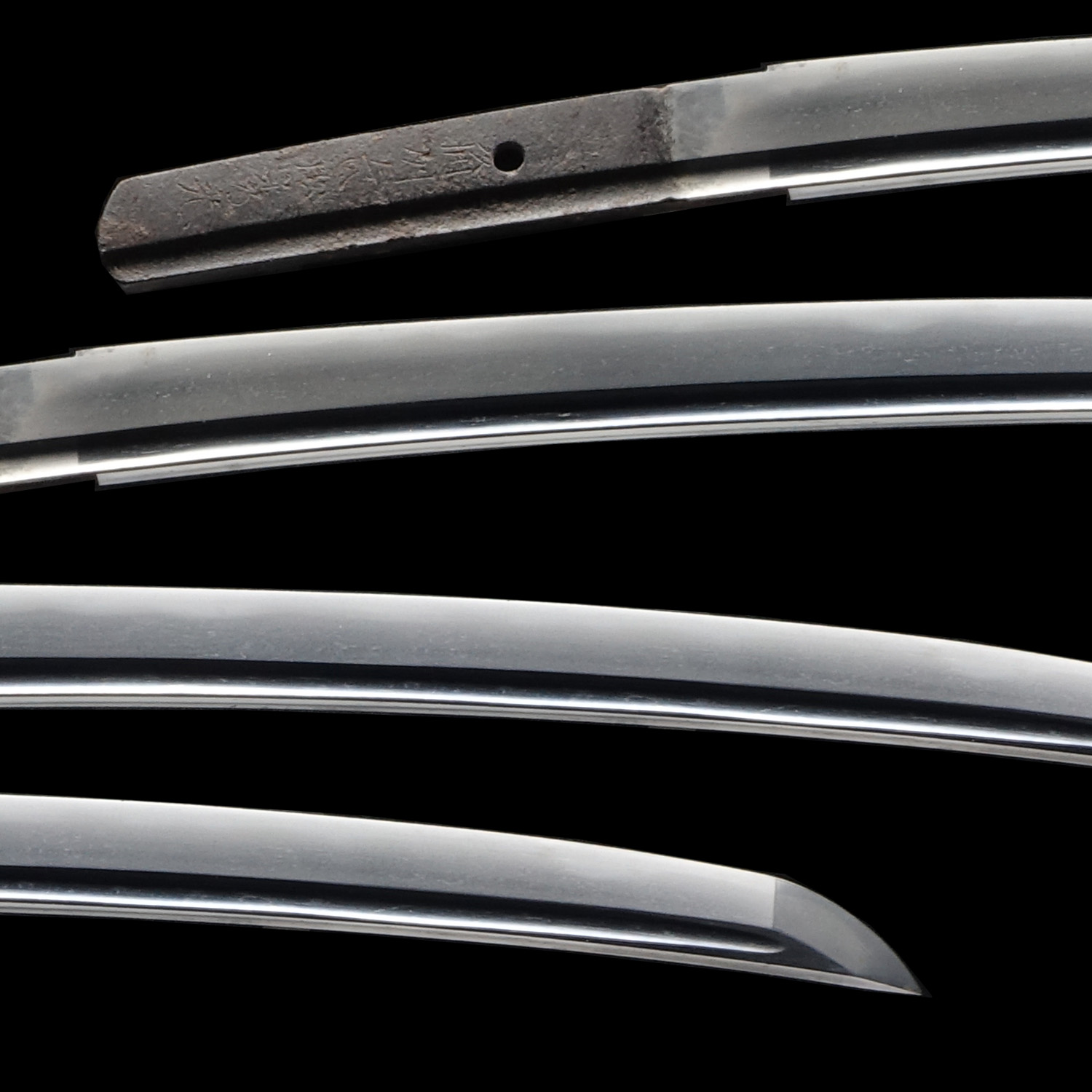
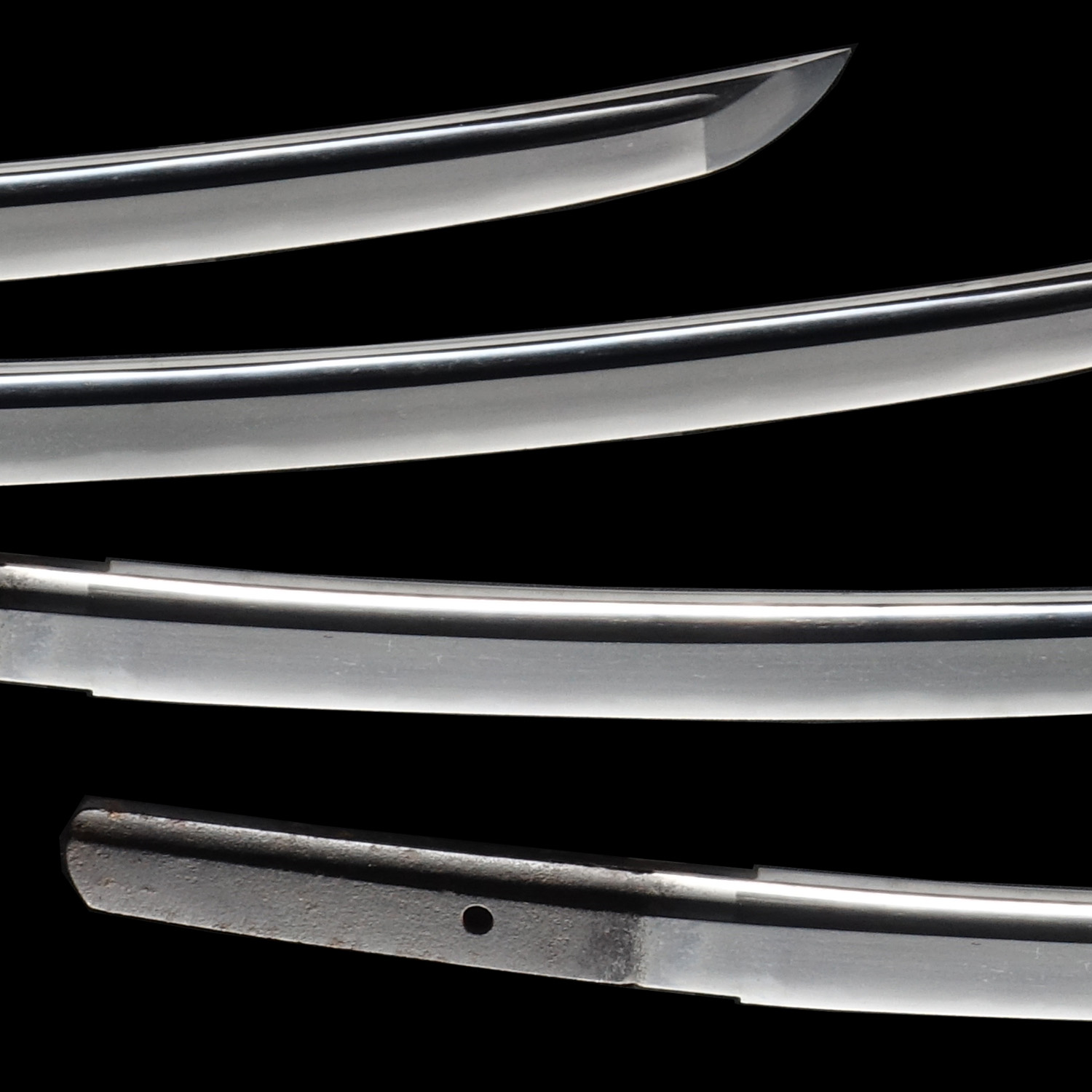
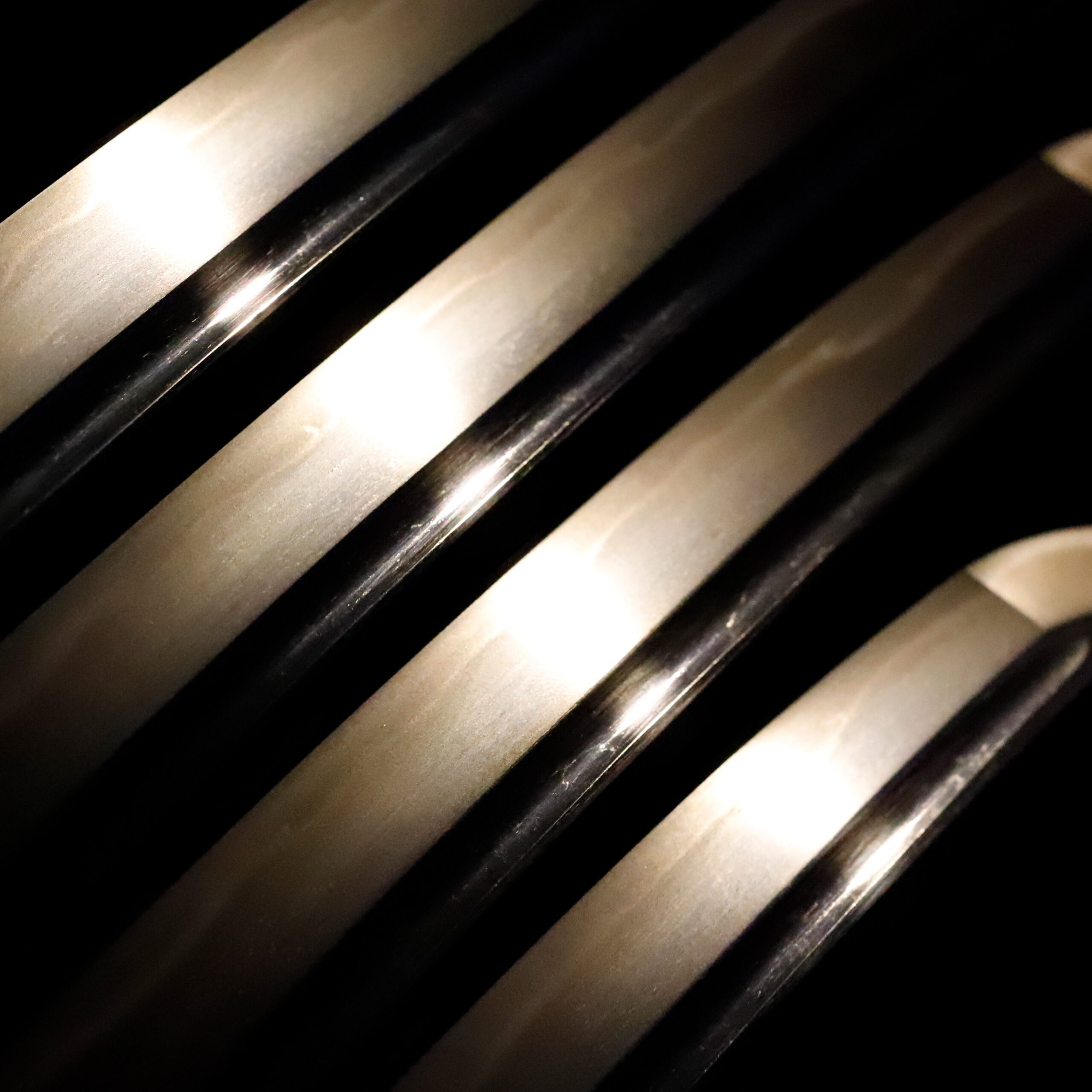
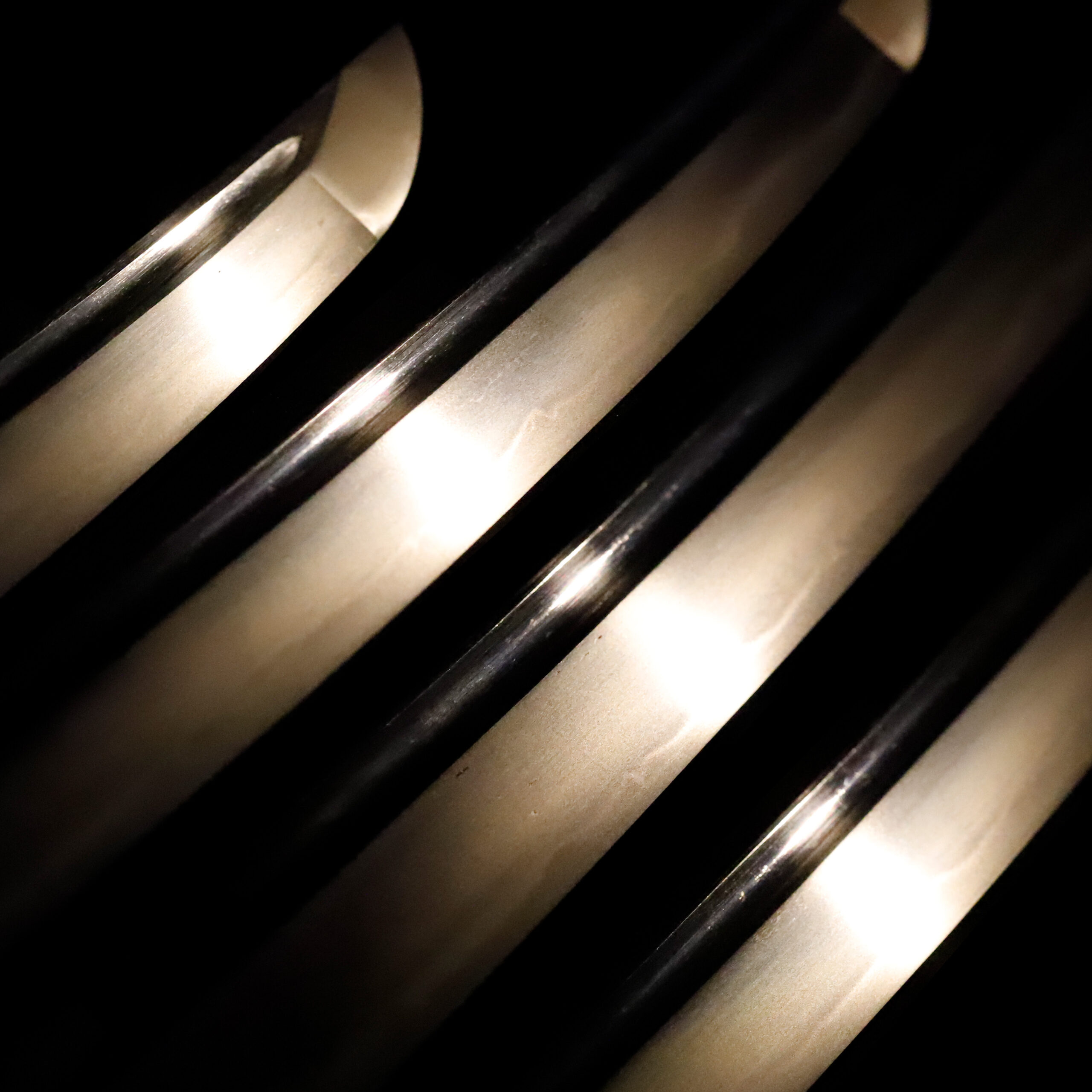
Nakago:Nakago is the tang of the Japanese sword.
Japanese swordsmiths left the black rust on the tang because it prevents red rust while the tang is in its handle. And the discoloration of the tang was created over time, and it is a great indicator for a Japanese sword specialist to estimate when the sword was forged.
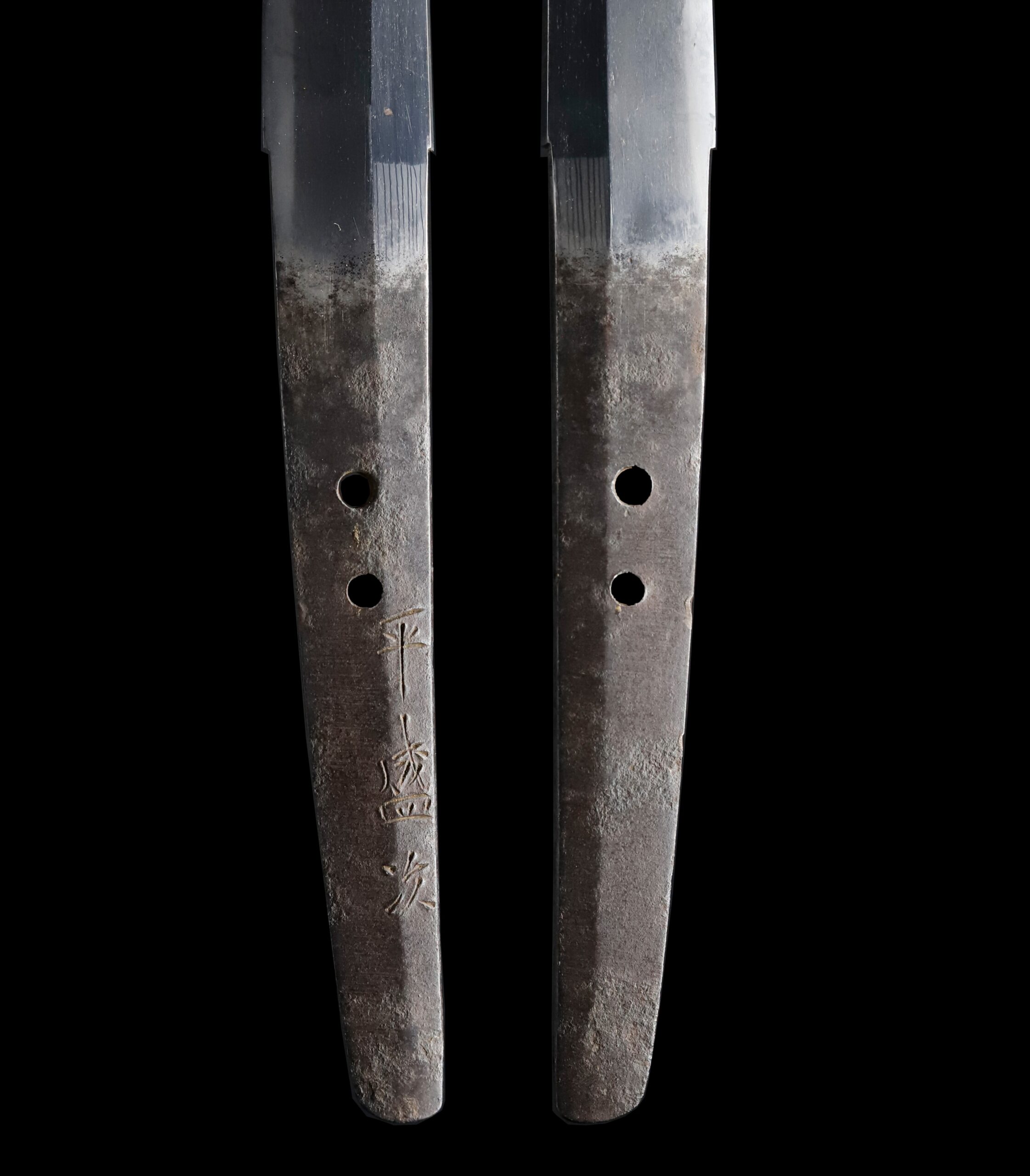
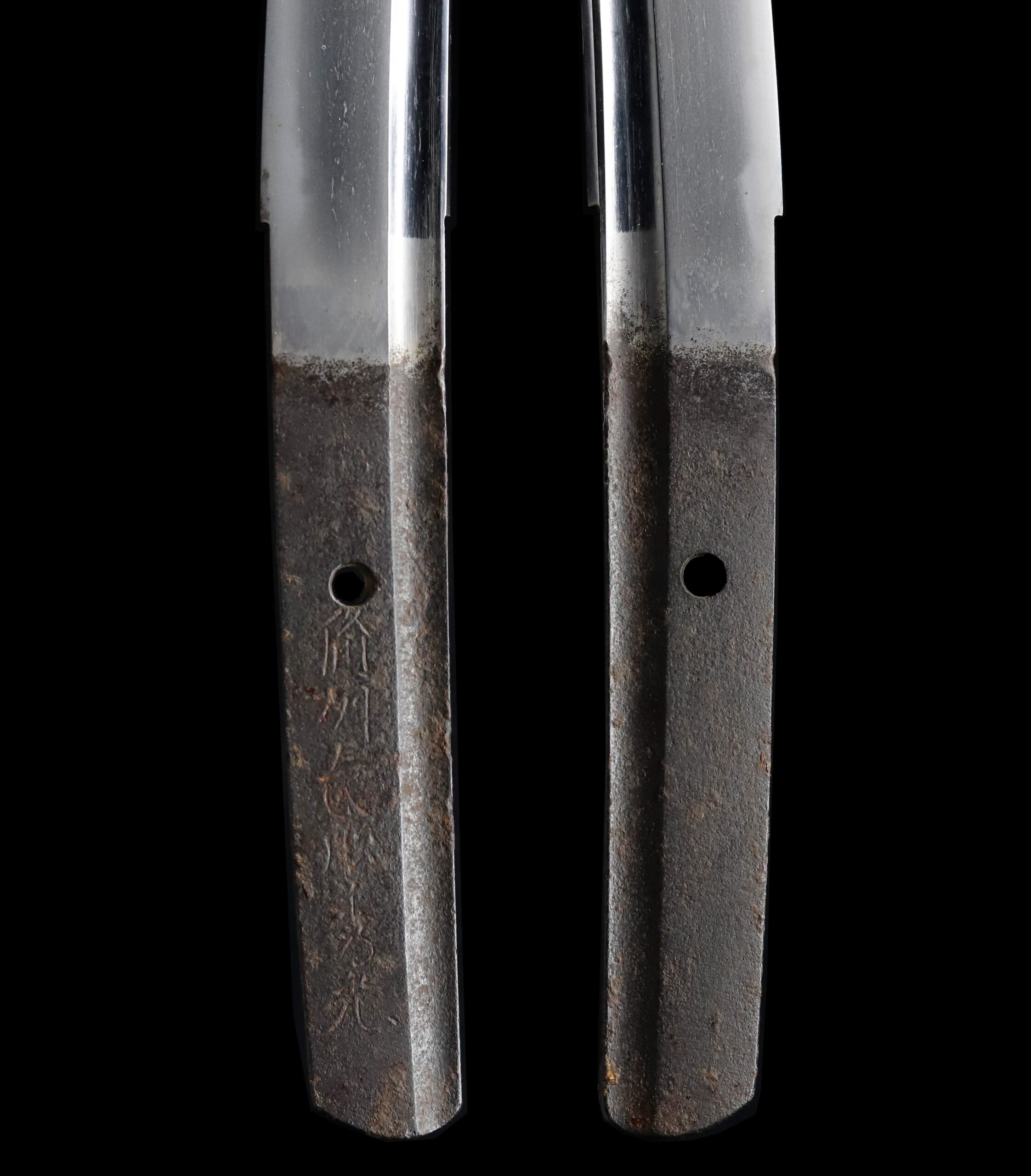
Koshirae: Koshirae is the mounting of the Japanese sword. There are several parts that consist of Koshirae such as Saya(Sabbard), Tsuka( Handle), Tsuba(Handguard).
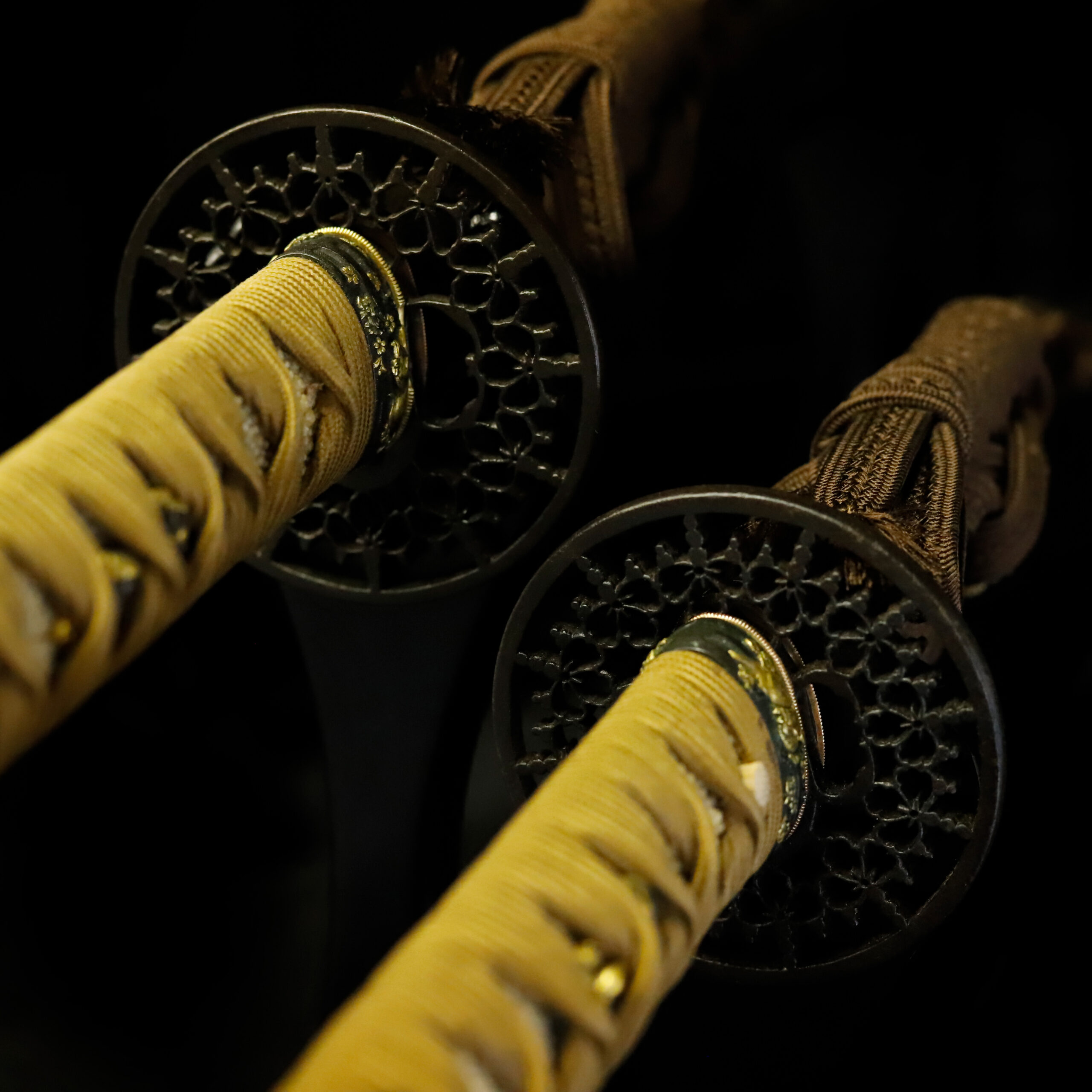
Fuchi-Kashira:A pair of matching sword fittings that cover the upper and bottom parts of its sword hilt.
The theme of the Fuchi Kashira is horse and cherry blossom.
Horses have been around human life for a long time, not only as our food but also for transportation or carriage of luggage. In Japan, horses were thought of as vehicles for gods to be dedicated to shrines in ancient times. It is said it is the origin of Ema (絵馬, picture tablet used as an offering at a shrine) today. Horses had been used as a tool for rituals and festivals. After the age that Samurai appeared, wearing large armor or performing archery riding a hose became martial arts. Equestrian tactics became the pillar of military action and security activities. According to a theory, that is why the Japanese sword began to have a curve to make it suitable for slashing (the Japanese sword was straight in the beginning).
Cherry blossom is one of the seasonal things of spring, and it has been loved for a long time in Japan. Its pattern is designed not only for sword mountings but also for Kimono (着物, traditional Japanese costume) or furnishings. One theory says that the god of grain exists in cherry blossoms. Therefore, this flower pattern has been treated as the symbol of a plentiful harvest. People held a traditional custom under cherry blossom trees to pray for a bumper year in ancient times. It is said this is the origin of the cherry blossom viewing picnic today.
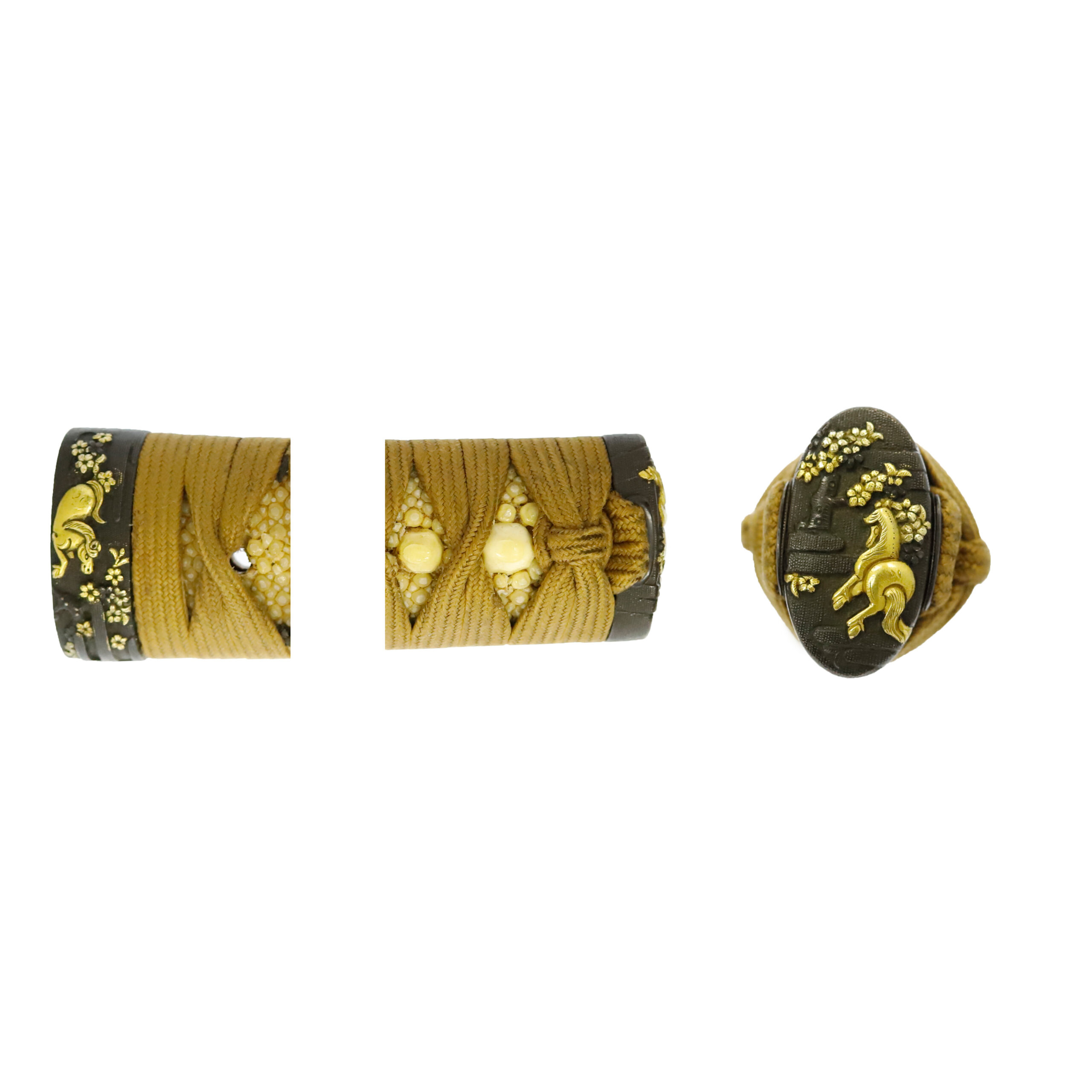
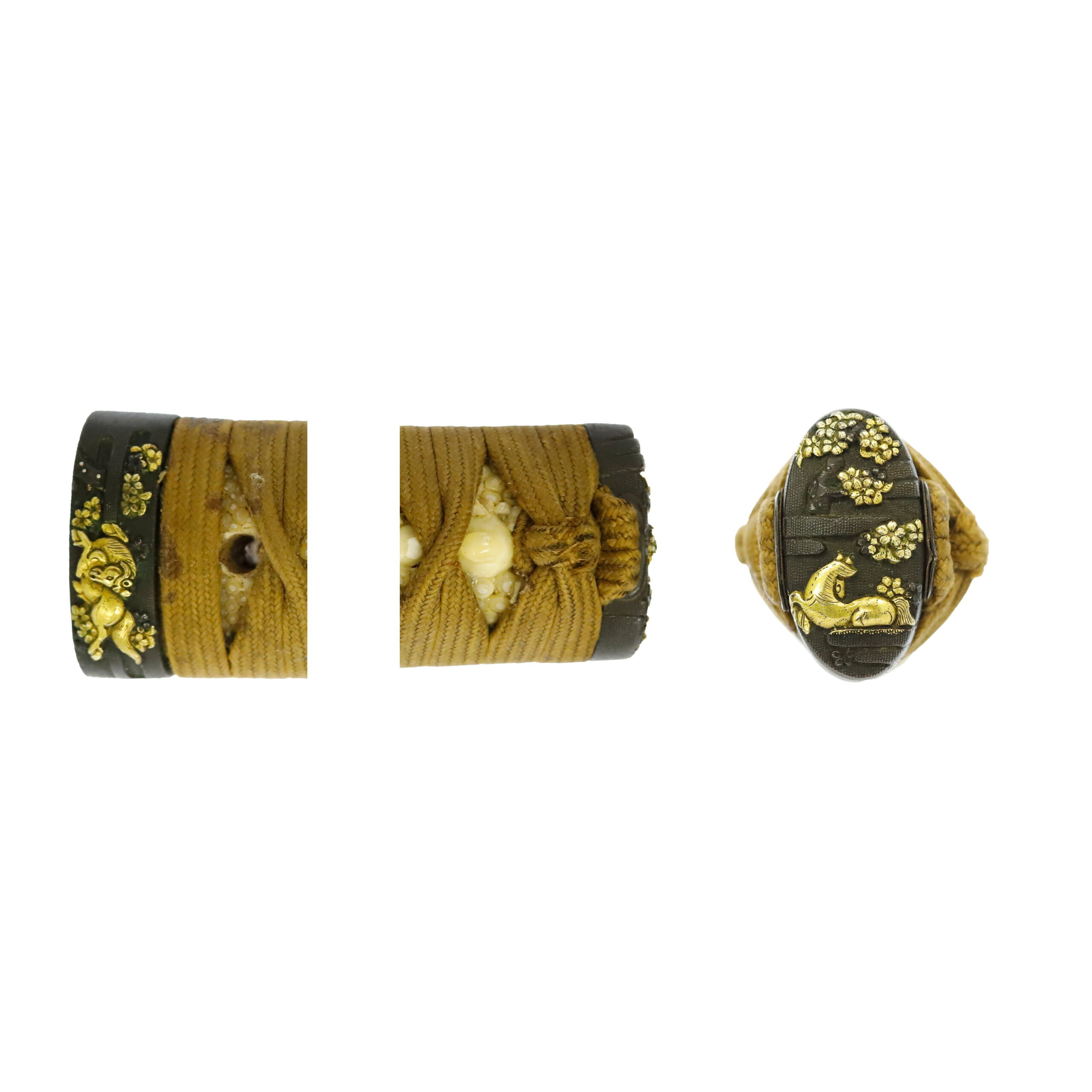
Tsuka and Menuki:Tsuka is the handle of the Japanese sword and Menuki is its decoration.
The horse and Hyotan (gourd) are depicted on the Menuki.
Since ancient times, Japanese people have appreciated this plant design as an auspicious motif. For example, a Hisago is written as “瓢,” which can also be read as “Hyou.” Therefore, three Hisagos were considered the San-Byoushi (三拍子, triple time, 拍子 can also be pronounced as Hyoushi). And people compared six Hisagos to Mubyou Sokusai (無病息災, be in perfect health). It is because the word “病 (Byou)” has the same pronunciation as “瓢 (it also can be read as Byou).” Also, the Hisago pattern represents success in business and the prosperity of descendants as this plant produces lots of fruits. These meanings tell you how Japanese people love this design based on its acting superstitiously for good luck.
Now, let’s briefly touch on an example of the relationship between the Hisago motif and the Samurai culture. Toyotomi Hideyoshi (豊臣 秀吉, 1537-1598) was one of the most famous Samurai warriors during the Warring States period (1467-1615). According to a theory, his Umajirushi (馬印, a massive flag raised near the general Samurai on the battlefield) was the Senari-Byoutan (千成瓢箪). He was given the Hisago motif for his Umajirushi from Oda Nobunaga (織田 信長, 1534-1582). It is said he added gourds every time he won the battles. We imagine this plant motif has been treated as an auspicious symbol and cherished among Samurai warriors.
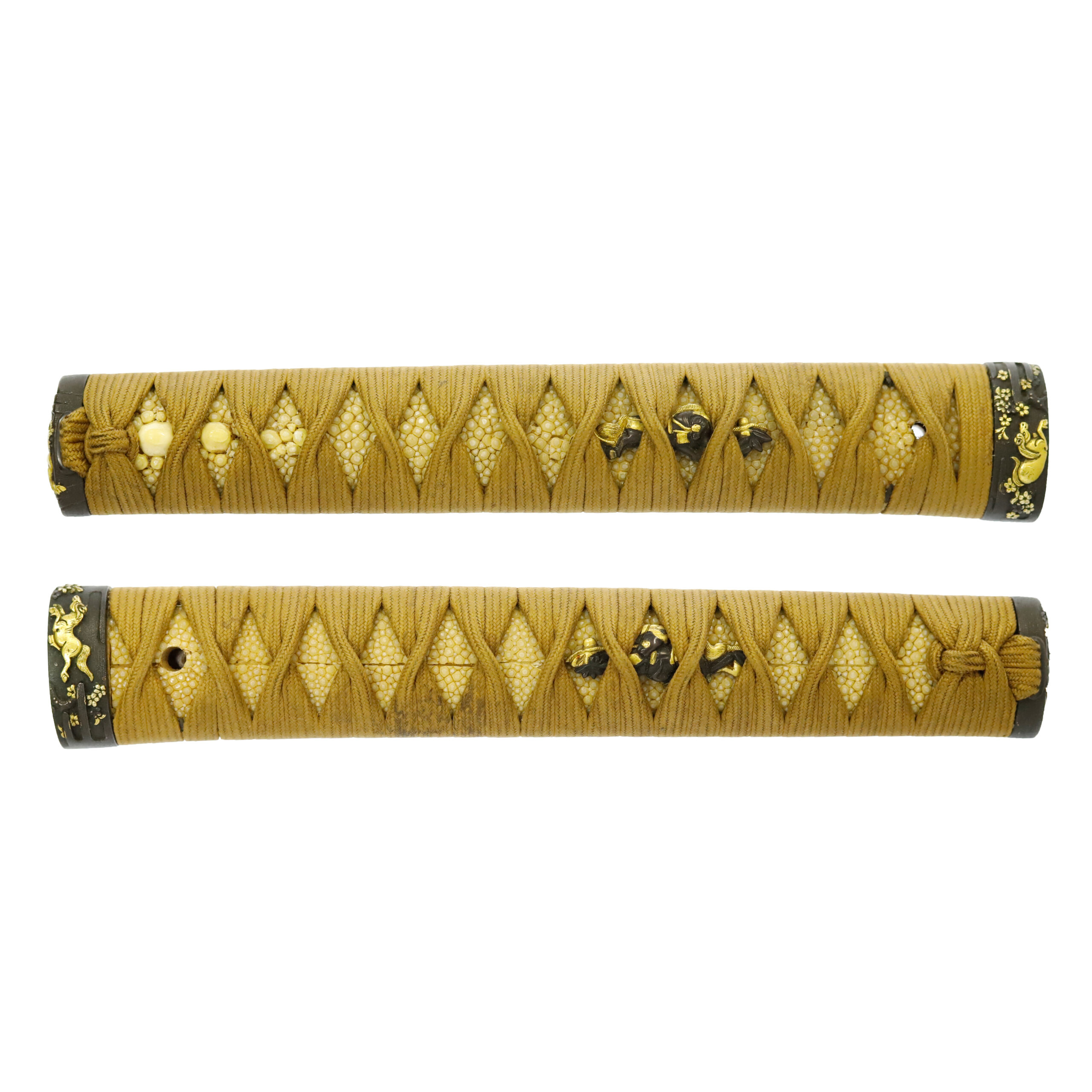

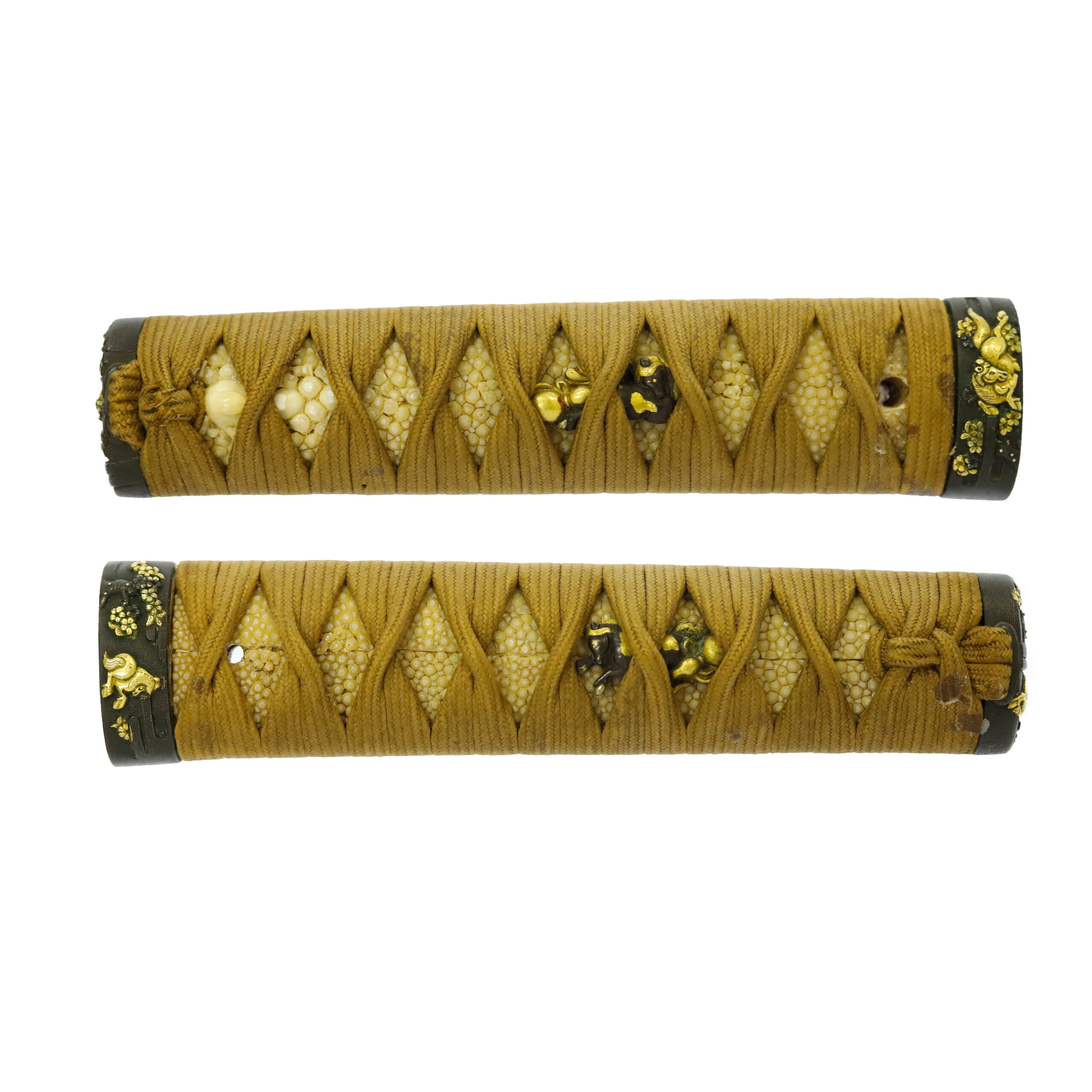

Tsuba and Habaki:Tsuba is the handguard for the Japanese Sword and Habaki is the equipment to make the blade not touch its scabbard inside. It prevents the blade from getting rusty and chipped.
The Kiri (桐, Paulownia) pattern is designed on the Tsuba. Each Kiri is arranged evenly and beautifully; it looks like the gears of a water wheel. Gosan-no-Kiri Monyou (五三の桐文様) is a popular design that the paulownia motif is used. This pattern was once used by the imperial family and people in authority at that time. Today, it is permitted to use by ordinary households and is appreciated as their family crests. According to a tradition, Houou (鳳凰, Fenghuang, a kind of sacred beast) rests its wings at the paulownia tree; therefore, it has come to be regarded as a holy plant. It is also famous that one of the most popular Samurais in Japan: Toyotomi Hideyoshi used the Kiri pattern for his family crest. This plant pattern was once used by the imperial family and national leaders of the time.
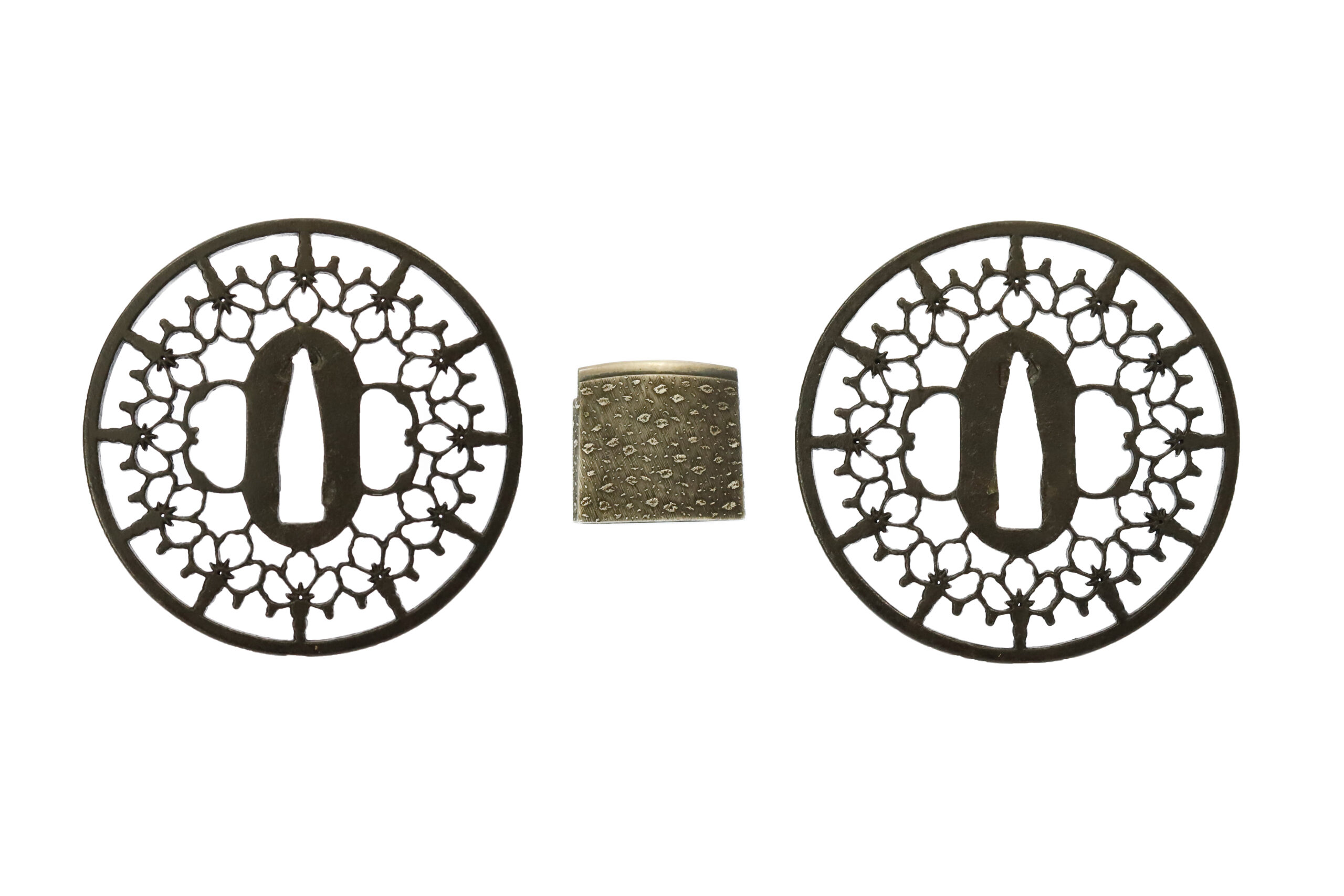

Saya: Saya is the scabbard for the Japanese sword.
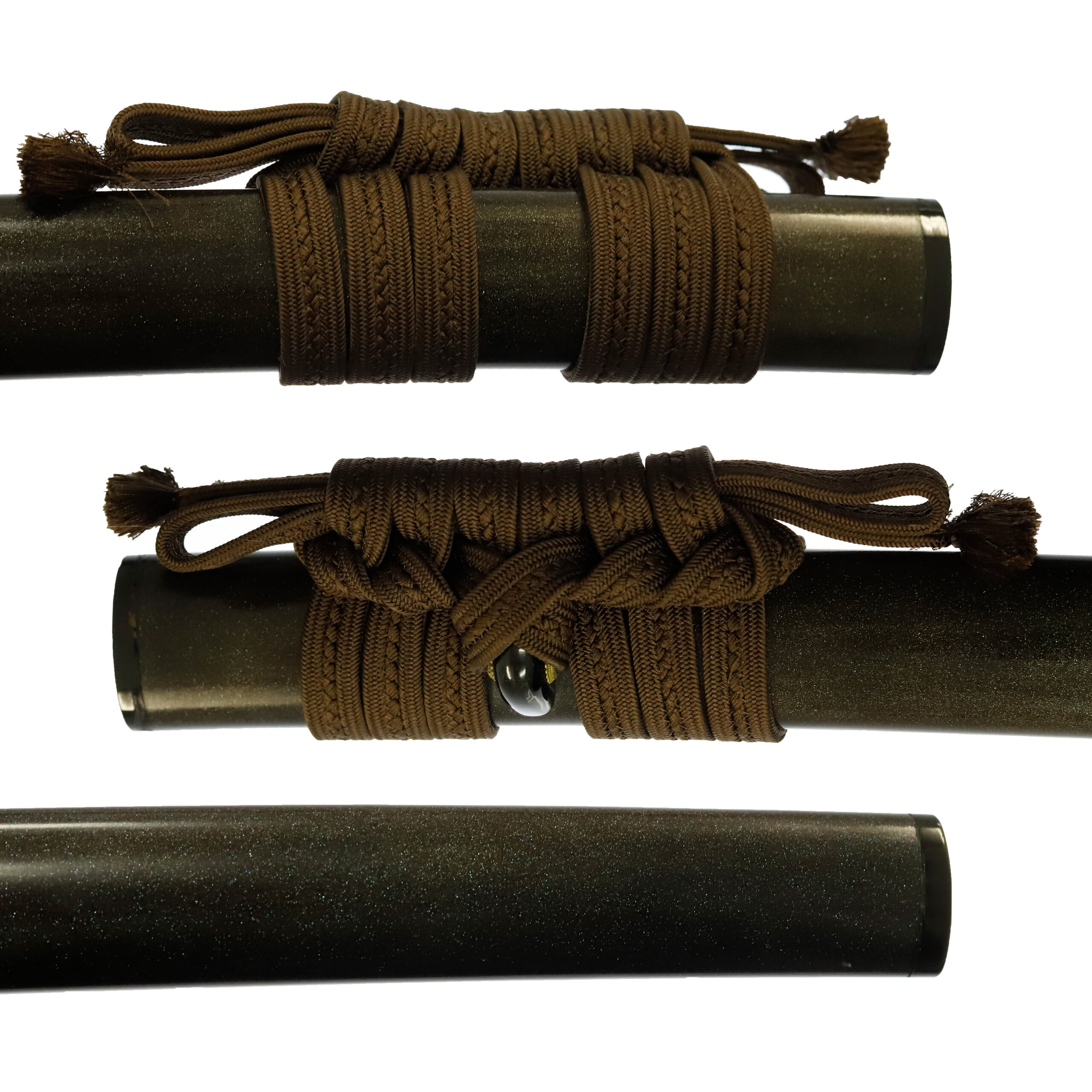
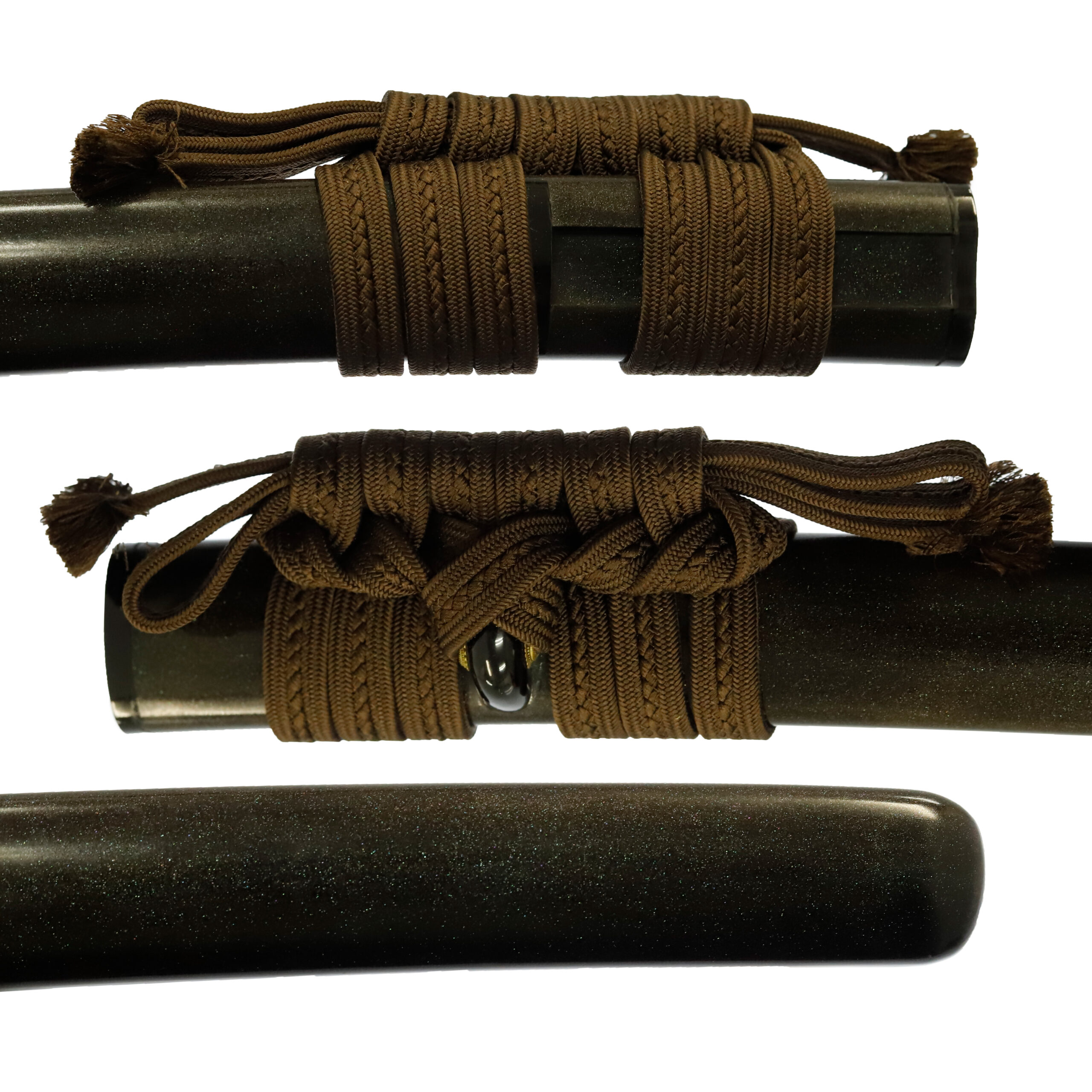
Authentication Paper:NBTHK Tokubetsu Hozon Certificate for the Katana and Wakizashi (No. 1021220, No.1021208)
NBTHK, also known as Nihon Bijutsu Touken Hozon Kyokai (the Society for the Preservation of the Japan Art Sword), is one of the oldest Japanese sword appraising organizations in modern-day Japan. They authenticated these two blades on August 25th in the 5th year of Reiwa(2023). They appraised both blades as a Tokubetsu Hozon Touken, the blade especially worth preserving for Japanese society. The purchaser will receive these original certificates as well. We can also translate what is written into English and make a PDF file for your record if you request.
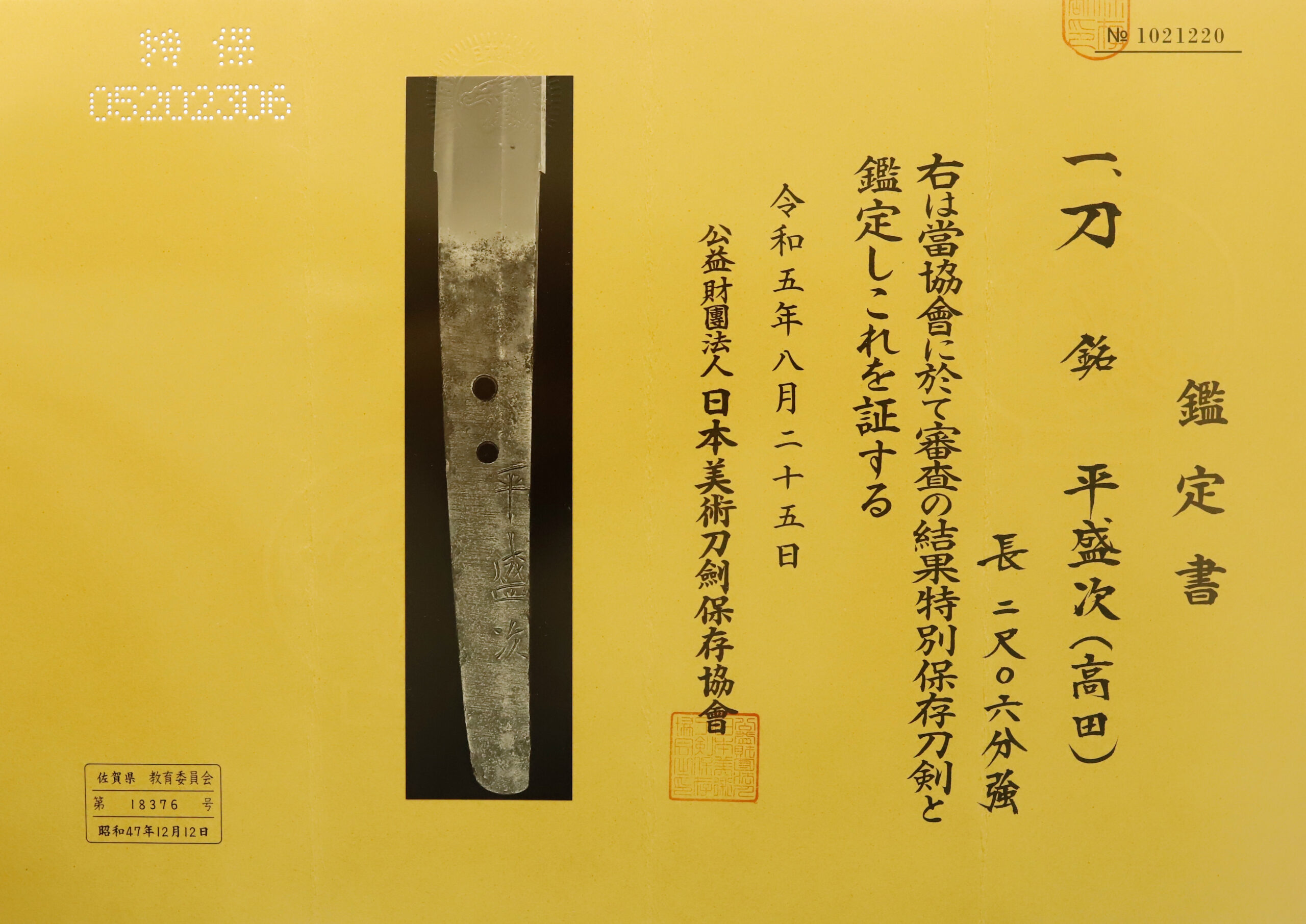
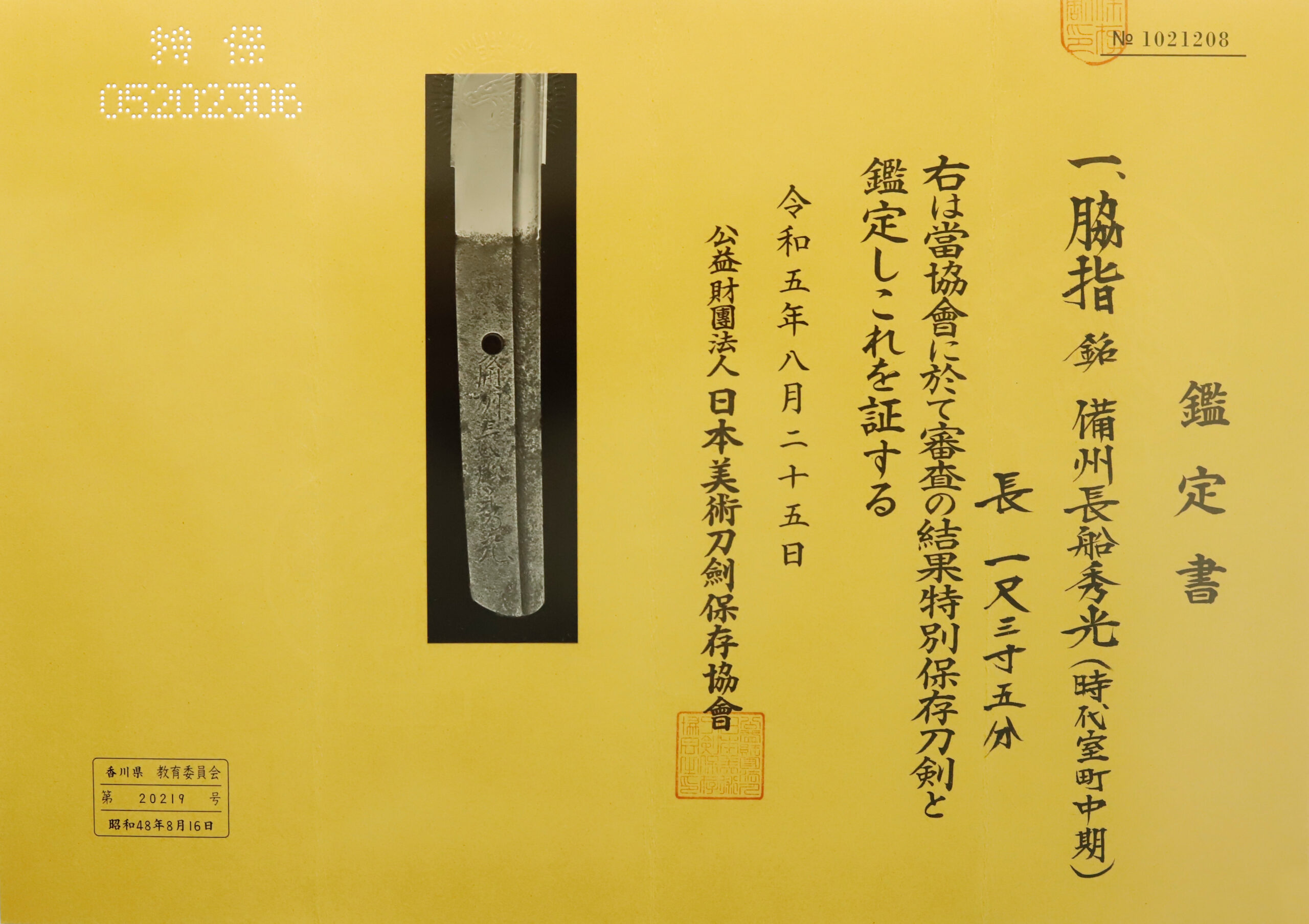
Registration Number : Saga 18376-Kaga 20219
The Board of Education in Saga prefecture issued a registration paper for this Katana and that in Kaga prefecture issued it for the Wakizashi blade . It is called Jyu Token Rui Torokusho(銃刀剣類登録証). Bunkacho(The Agency for Cultural Affairs) acknowledges a Japanese sword with this paper as a work of art.
The sword needs to be traditionally hand-forged and made of Tamahagane carbon steel to be registered in the system. With this paper, its owner in Japan can legally own an authentic Japanese sword. Based on this registration number, we will apply for its export permit.
This paper will need to be returned to the board of education when the sword is being shipped abroad, but you can receive a copy of it. An English translation of this registration paper is available on request.

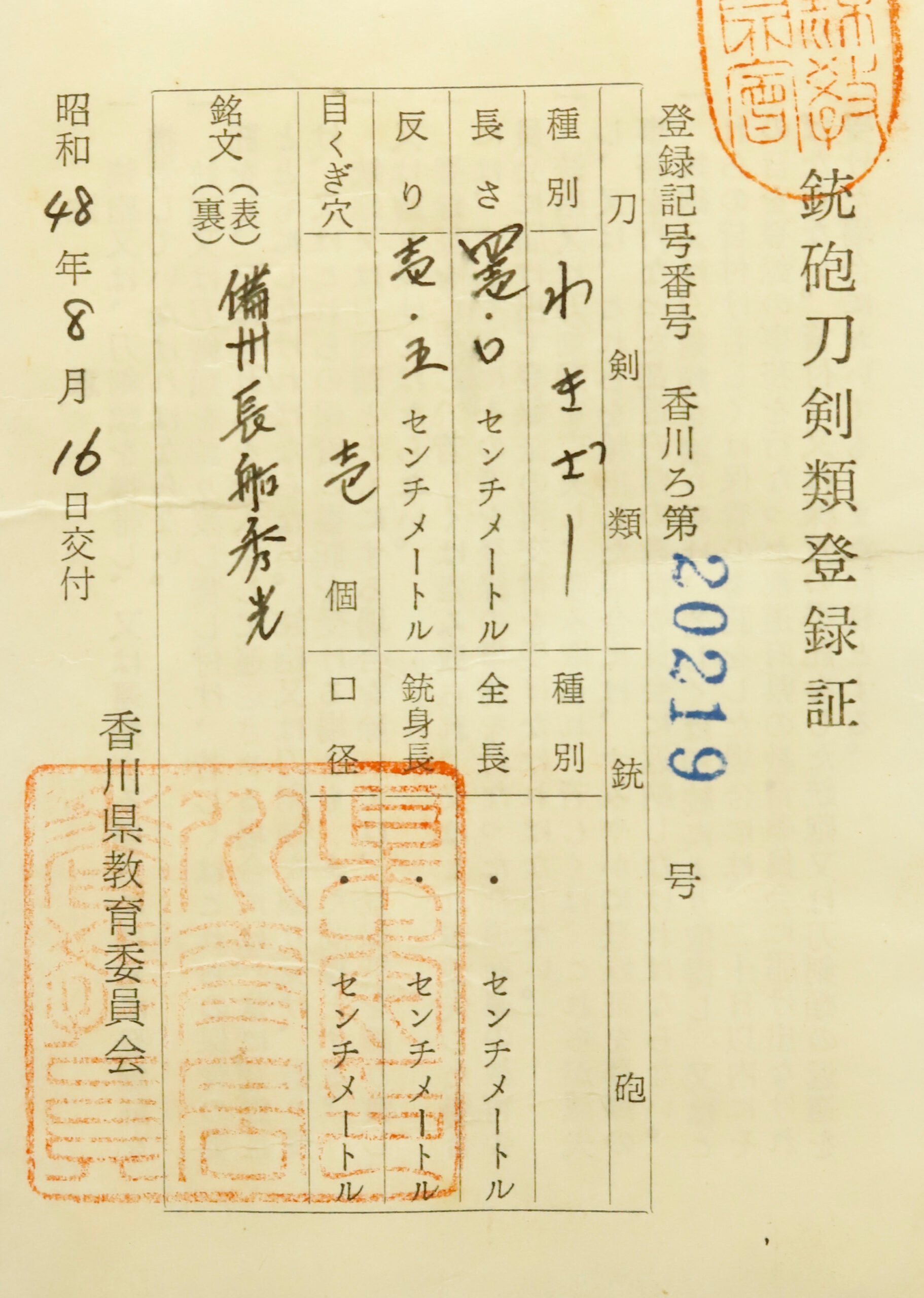
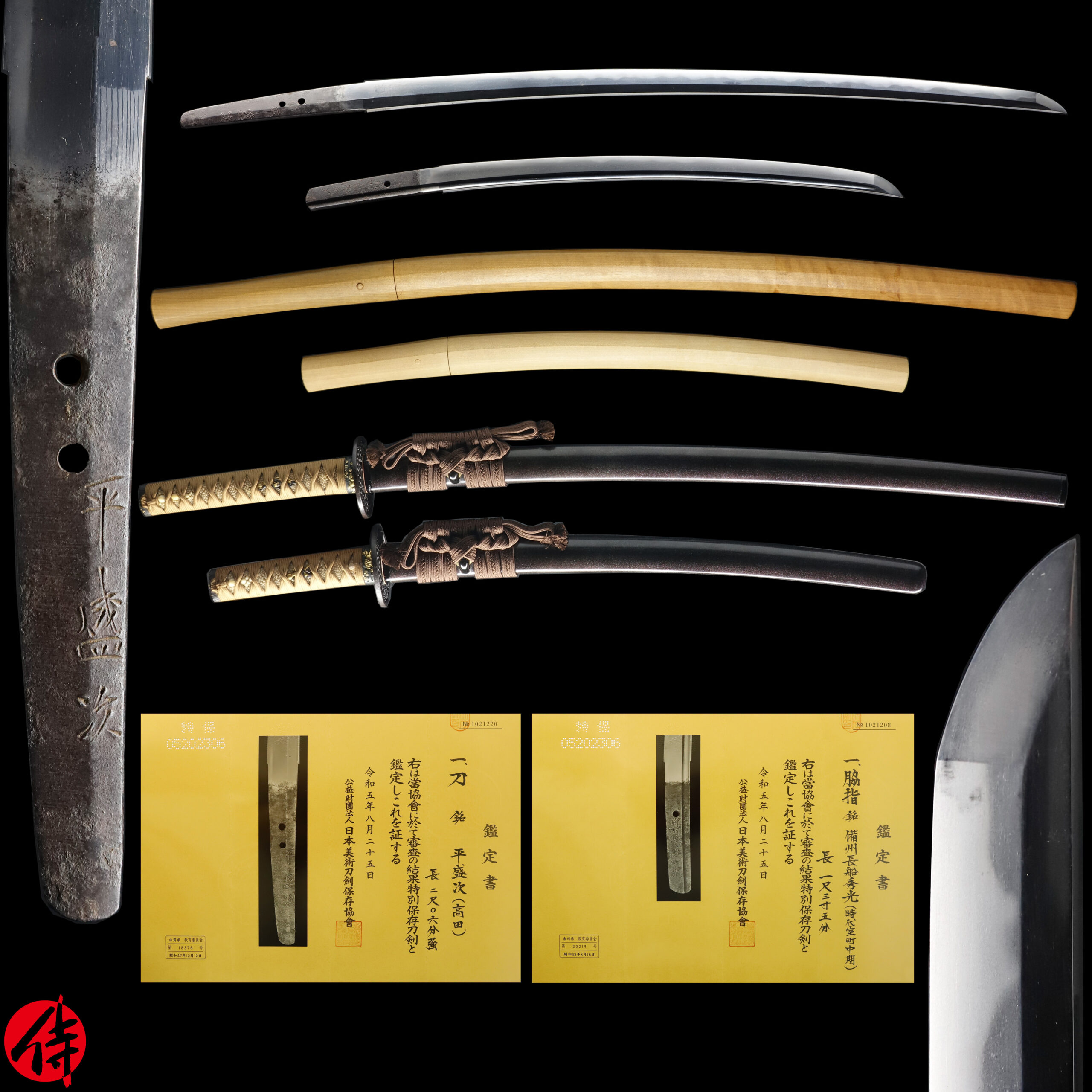
—————————————————————–
【About us】
Samurai Museum is located in Tokyo, Japan, exhibiting antique artifacts related to the Samurai history. Samurai Museum Shop is the place for those who are interested in Japanese culture and craftsmanship. We deal with antique Samurai swords/armor, traditional crafts made in Japan and so on.
【Japanese Sword& Export Process】
The Japanese swords we deal with are hand-forged edged swords made in Japan. It was made from the traditional carbon steel called TAMAHAGANE(玉鋼). Samurai Museum is familiar with the proper legal procedure for an antique/ authentic Japanese sword to be exported from Japan. We have sent more than 500 Japanese swords for the past three years (~2023) to amazing owners who appreciate its historical value.
Each Japanese sword is registered under the Agency for Cultural Affairs and the Board of Education in Japan. They issue a registration paper for each Japanese sword for its owner in Japan to legally possess it. The Japanese sword with its registration paper means it was traditionally hand-forged in Japan.
To legally export the sword from Japan to other countries, we will have to apply for its permit to the Agency for Cultural Affairs(Bunkacho) and return the original registration paper to the Board of Education. It normally takes around 2-4 weeks to receive this permit after submitting required documents. And we would like you to expect at least 1-1.5 months for your order to arrive at your given address after you ordered. For more detailed info, please click here.
It is allowed for residents in Japan to own authentic Japanese swords without a special license as long as they come with registration papers. Please feel free to contact us if you are a resident of Japan, whether temporarily or permanently. We will also assist you when you leave Japan and need to obtain the export permit.
【Payment Method】
We accept payment through Stripe (Credit card), PayPal, Apple Pay or ChromePay, all of which are secure payment methods. Also, you don’t need to make an account on Stripe for the checkout. If you prefer other payment method, please contact us. After confirming your payment, we will apply for an export permit. You may either pay in JPY, USD, AUD, CAD,EUR CHF or GBP. The price is set in Japanese Yen. Prices in other currencies are automatically calculated based on the latest exchange rate.

* If the amount is above 1 million JPY, Stripe or wire transfer will be the only options for payment.
【Shipping】
We have shipped authentic Japanese swords to the USA, UK, Canada, Mexico, Germany, France, Hong Kong and Australia. If you don’t live in these countries and like to order, please contact us first before making a purchase. We offer Free International Shipping as long as we can send antique Japanese swords by EMS.
We normally ship by EMS(Express Mail Service) provided by Japan Post. We will send you a tracking number for your order as soon as we hand it to the post office. We will put 100 % insurance on the shipping document without any extra charge. Based on the total amount, there might be a duty tax or other fee for you to pay, depending on the countries. We use package cushioning to protect the item and put it in a PVC pipe, which is one of the most secure packages because of its durability.
It will normally takes 5-14 days for the item to arrive at your given address after we dispatch it. Time of delivery is estimated as accurately as possible by the carrier but does not take into account any delays beyond our control such as by inclement weather, post office holiday seasons.
* If you live in Australia and like to purchase an authentic Japanese sword, please click here to know the detail.
*Please keep in mind that due to the spread of COVID-19, there might be delays in shipping. If you like to know the detail about shipping, please feel free to ask us.

【Review】
Here is one of the reviews we received from a customer who purchased an authentic Japanese sword from us. For more reviews, please click here.
“My experience overall with the whole process was wonderful. I had many questions about the history and process to purchase these treasures. All my questions were answered very timely and complete. The staff is very knowledgeable and very well versed if any questions do arise.”
【How to make sure the condition】
Please keep in mind that what you are going to purchase is an antique item. We uploaded high resolution photos for you to check its condition thoroughly. If you like to see more photos with different angles, please feel free to contact us. We will be happy to send them to you so that you can make informed decision. It is essential for us to know that you are happy with your choice of a sword. and we are prepared to use the best of our ability to serve you.
【How To Contact Us】
Please contact us through email, Facebook Messenger or Live Chat if you have any questions. You can find each icon on the right side of the website. Please click one of them to reach us. We will reply to you within 1-2 business days.
【The Art of Nihonto (Japanese Sword)】
Samurai’s history is a profound, eloquent legacy of ancient Japanese warriors in which millions of people worldwide are being fascinated. If you like to find out the art of Nihonto, please click here.
【A Guide to Japanese Sword Maintenance】
After acquiring an genuine Japanese sword, it is also important to know how to take good care of it. Here is the special video for you. Mr. Paul Martin, Japanese sword expert, shows you how to give proper maintenance to your sword. By mastering how to clean the Japanese sword, its aesthetic beauty will last forever.
When you purchase a Japanese sword from us, you can get a Free Japanese sword maintenance kit. It comes with four tools(Choji Oil, Uchiko Whetstone Powder, Peg remover, Oil Applicator). By watching the video instruction above , you can enjoy learning how to maintain your Japanese sword while appreciating it. If you have any difficulty assembling the sword or cleaning the blade, you can feel free to contact us.


MORE ANTIQUE JAPANESE SWORD FOR SALE
SWORDS WITHOUT CERTIFICATES FOR SALE
LEARN JAPANESE SWORD TERMINOLOGY
Thank you for reading all the information on the page. If you have any difficulty choosing the right Japanese sword for you, we will be more than happy to help you find the one that speaks to you the most. Please feel free to contact us.
